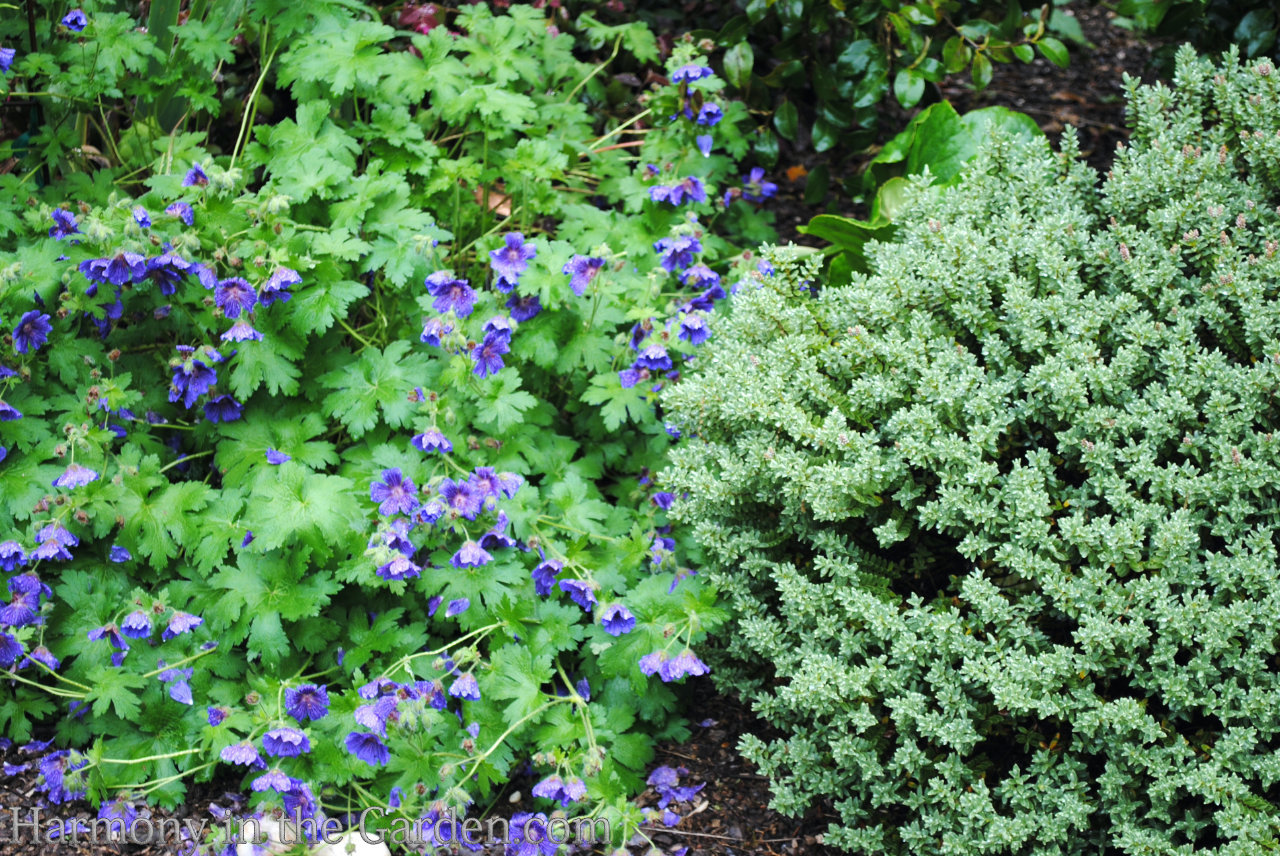
Geraniums and pelargoniums may look fragile and delicate, but they’re actually some of the hardest working plants in my garden.
Why?
They’re ignored by browsing deer, they take our never-ending drought with a grain of salt, and I even have a some in our zone 6 Lake Tahoe garden that don’t mind being buried under snow all winter!
They not only survive my challenging environment, but they offer loads of unexpected design opportunities.
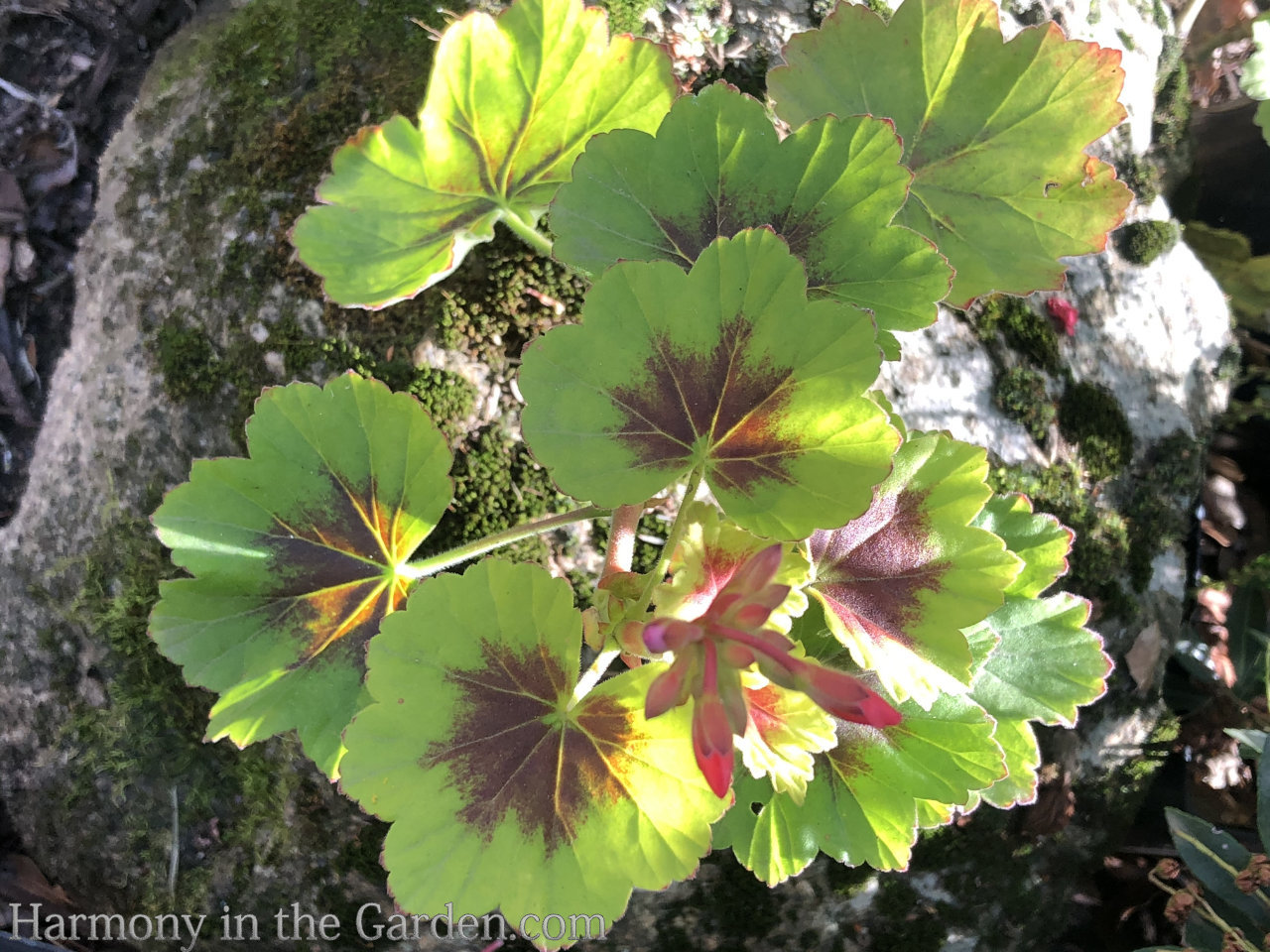
In this post, I’ll share some of my favorite ways to use them in the garden to achieve a variety of desired effects.
But before we get started, it’s important to spend a moment on the differences between geraniums and pelargoniums.
While they’re both in the same family – geraniaceae – the similarity ends there.
Geraniums
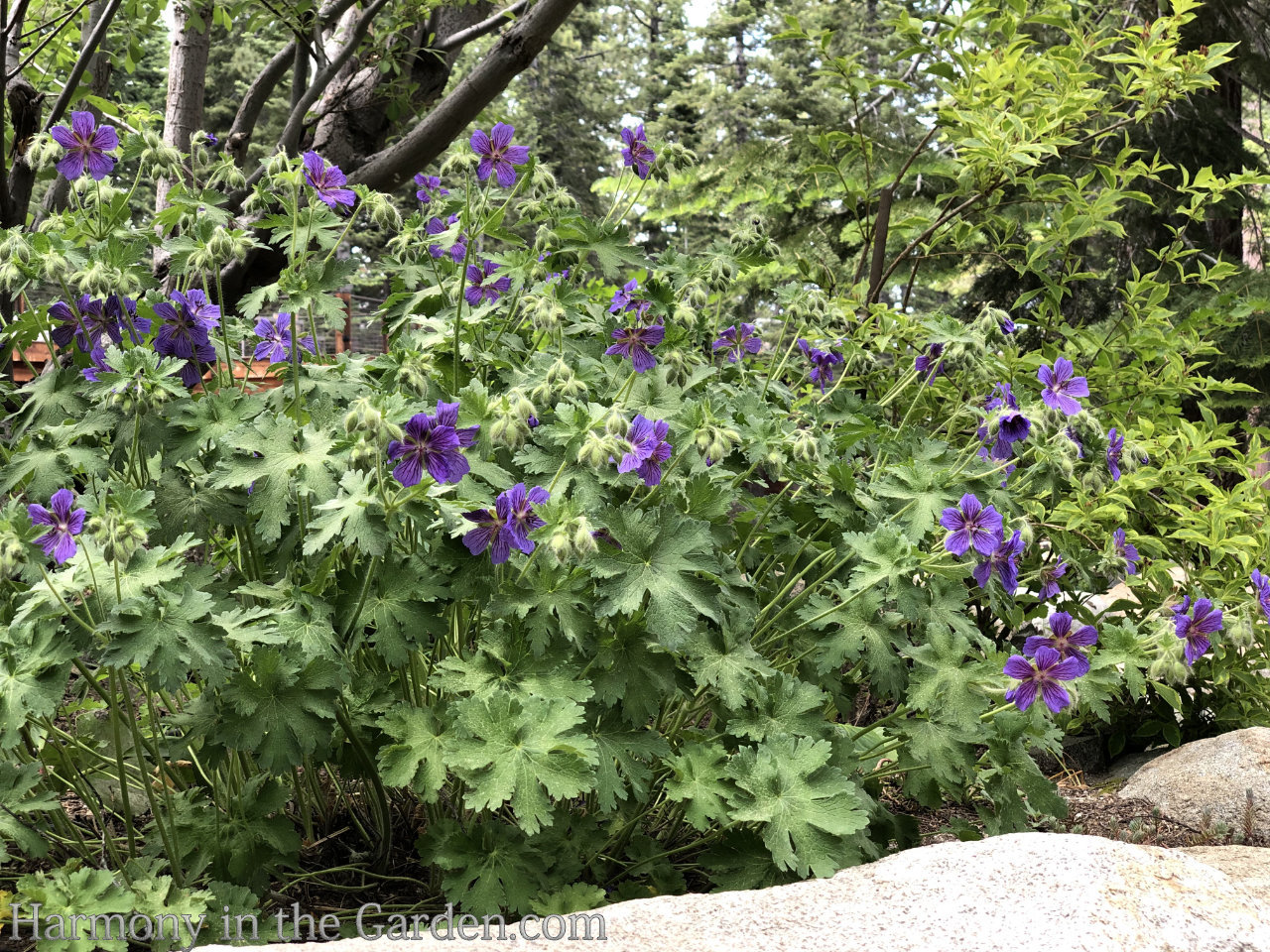
Geraniums are also known as Hardy Geraniums, True Geraniums, or Cranesbill Geraniums (the seedpods look like a crane’s beak, hence the name)
These are much tougher than pelargoniums and are considered cold hardy perennials, with many varieties surviving down to zone 5.
Geraniums have thin, wiry stems that support clusters of flowers and little fuzzy buds.
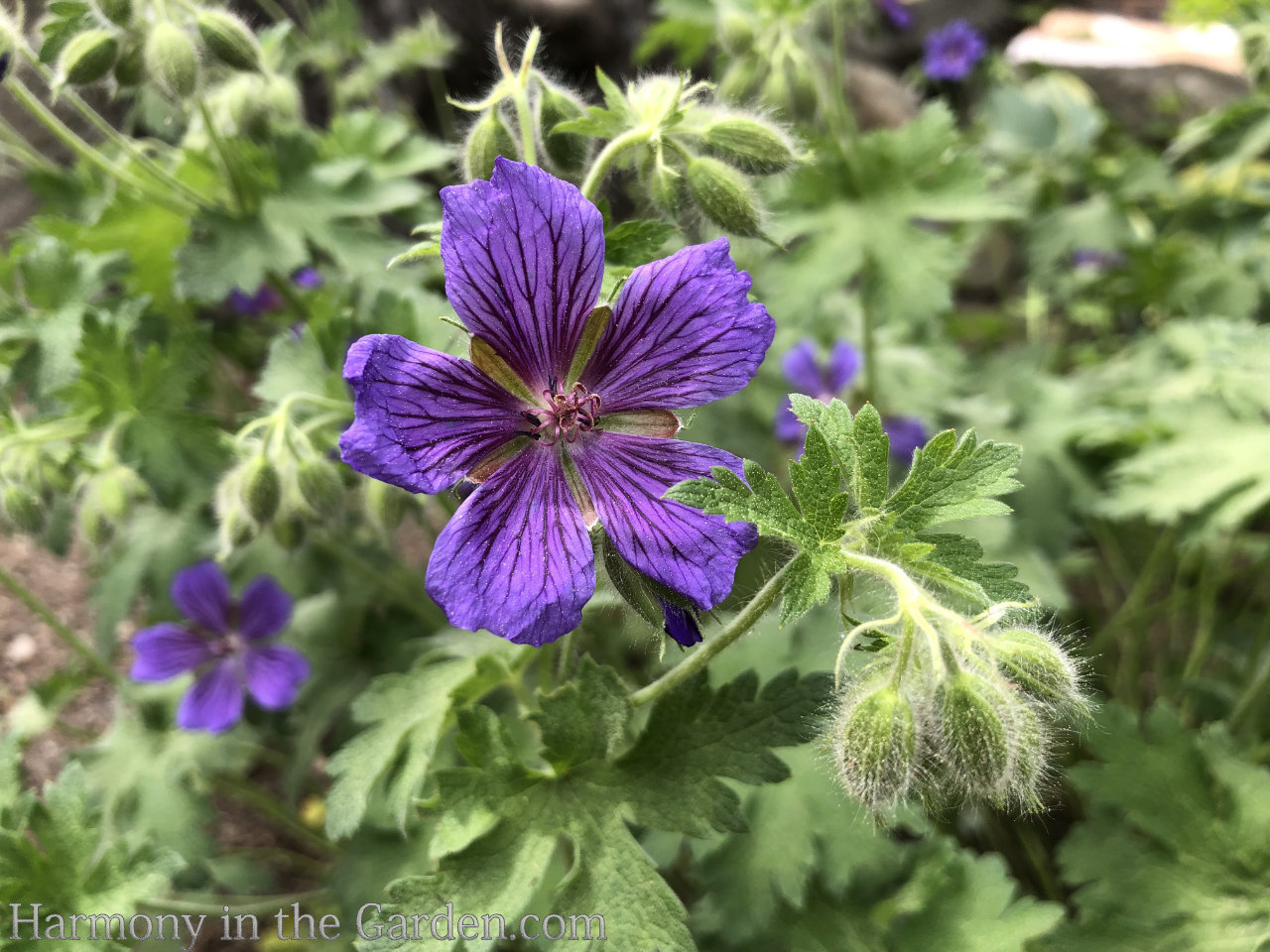
Typically, each cheery geranium flower is small (about .5-1.5″ wide), symmetrical, and has five single petals. Not always, but usually.
Geraniums also tend to grow lower to the ground and are often used in front of the border or as a ground cover.
While some varieties have colorful foliage, they aren’t usually as splashy as the ‘zonal geraniums’ (which aren’t geraniums, but pelargoniums – sorry…I’m getting ahead of myself.)
Nevertheless, their foliage is still an attractive feature of the plant, as you’ll see below.
Pelargoniums
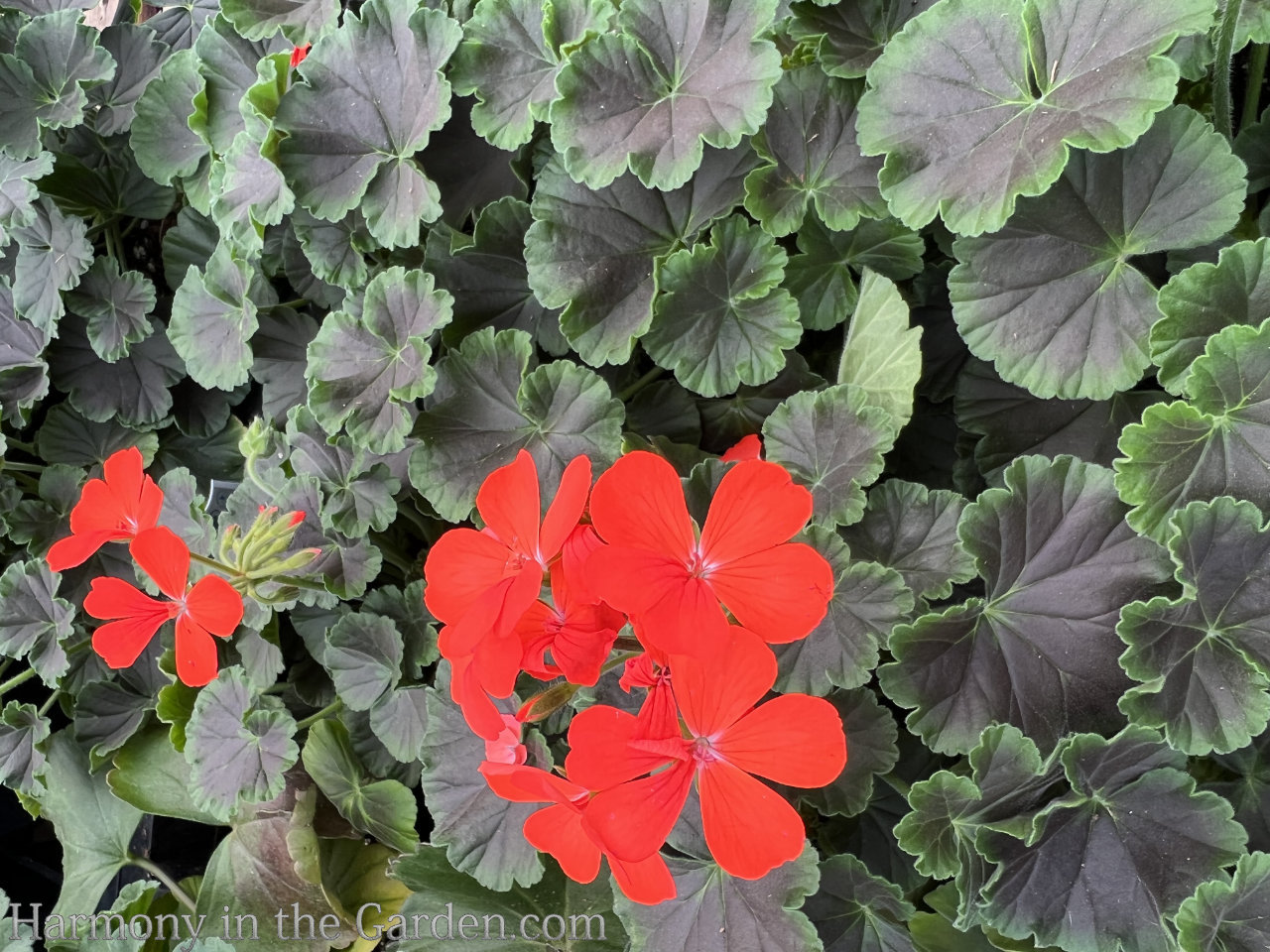
Pelargoniums, on the other hand, are more tender than ‘true geraniums’, and are generally considered annuals in areas with prolonged frost.
The flowers of the pelargonium are often asymmetrical, with 2 upper petals and 3 small lower ones.
Most pelargoniums are only hardy down to zone 8.
If you live in a colder climate, you can overwinter them in a greenhouse, or in the house near a brightly lit window.
Pelargoniums can grow taller than geraniums, with stems becoming woody and a bit leggy.
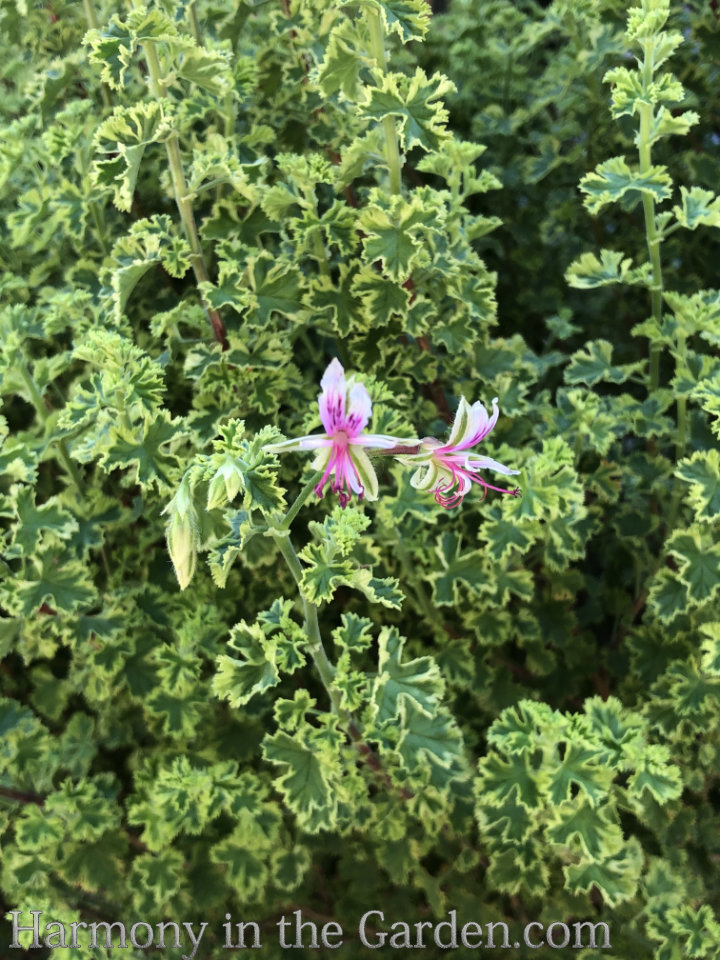
Here’s where things get a little tricky.
Many plants that people think of when they hear ‘geraniums’ are, in fact, pelargoniums.
For example, the Zonal Geraniums (like the ‘Brocade Fire Night’, below) aren’t geraniums, but are actually pelargoniums.
Or the Scented Geraniums (like the ‘Golden Lemon’, left), which aren’t geraniums either – you guessed it, they’re pelargoniums.
Confusing, I know. You’re not alone! Anyway, now that we’ve cleared things up, let’s discuss how I use these in the garden.
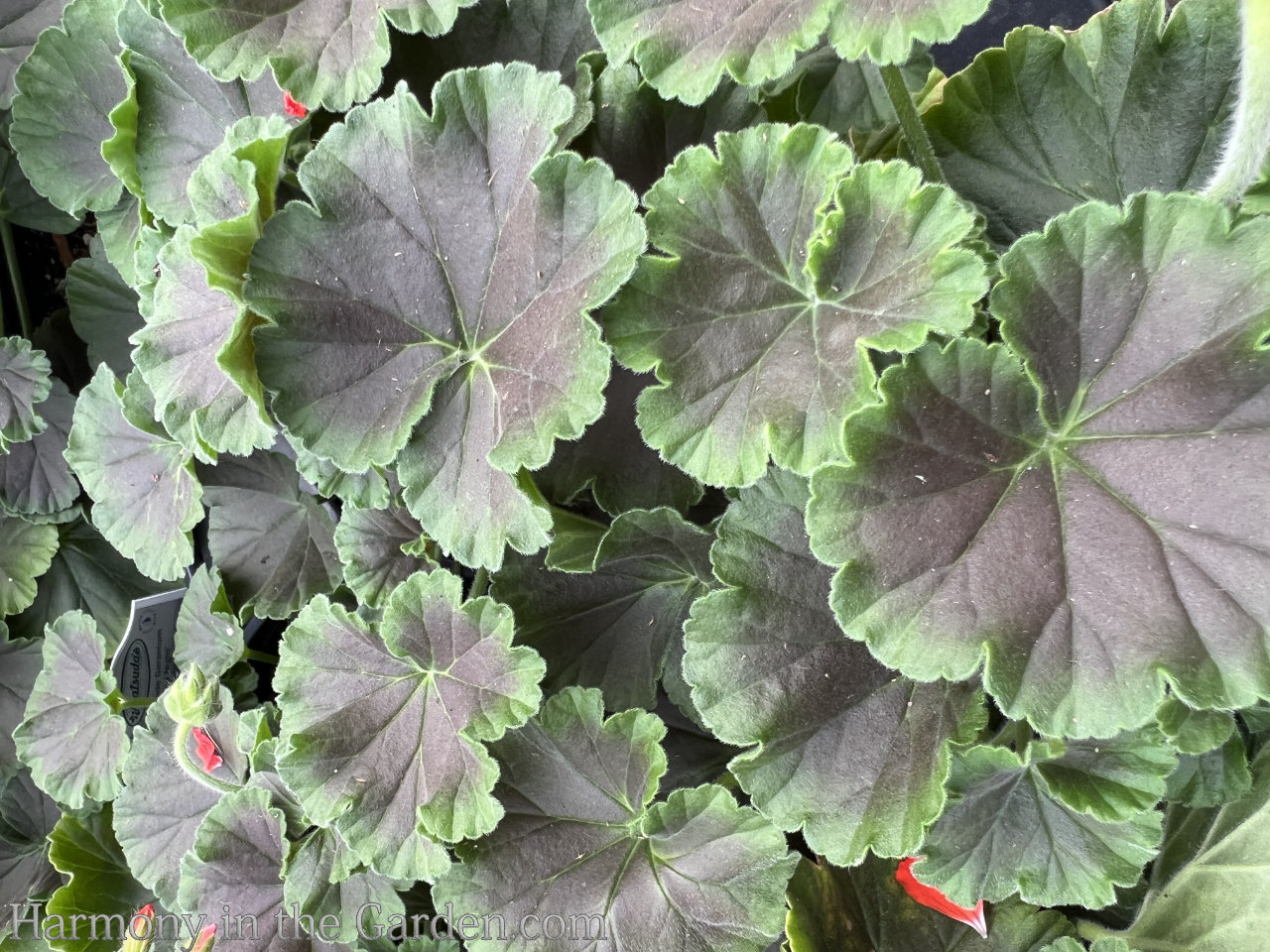
How I Design with Geraniums and Pelargoniums
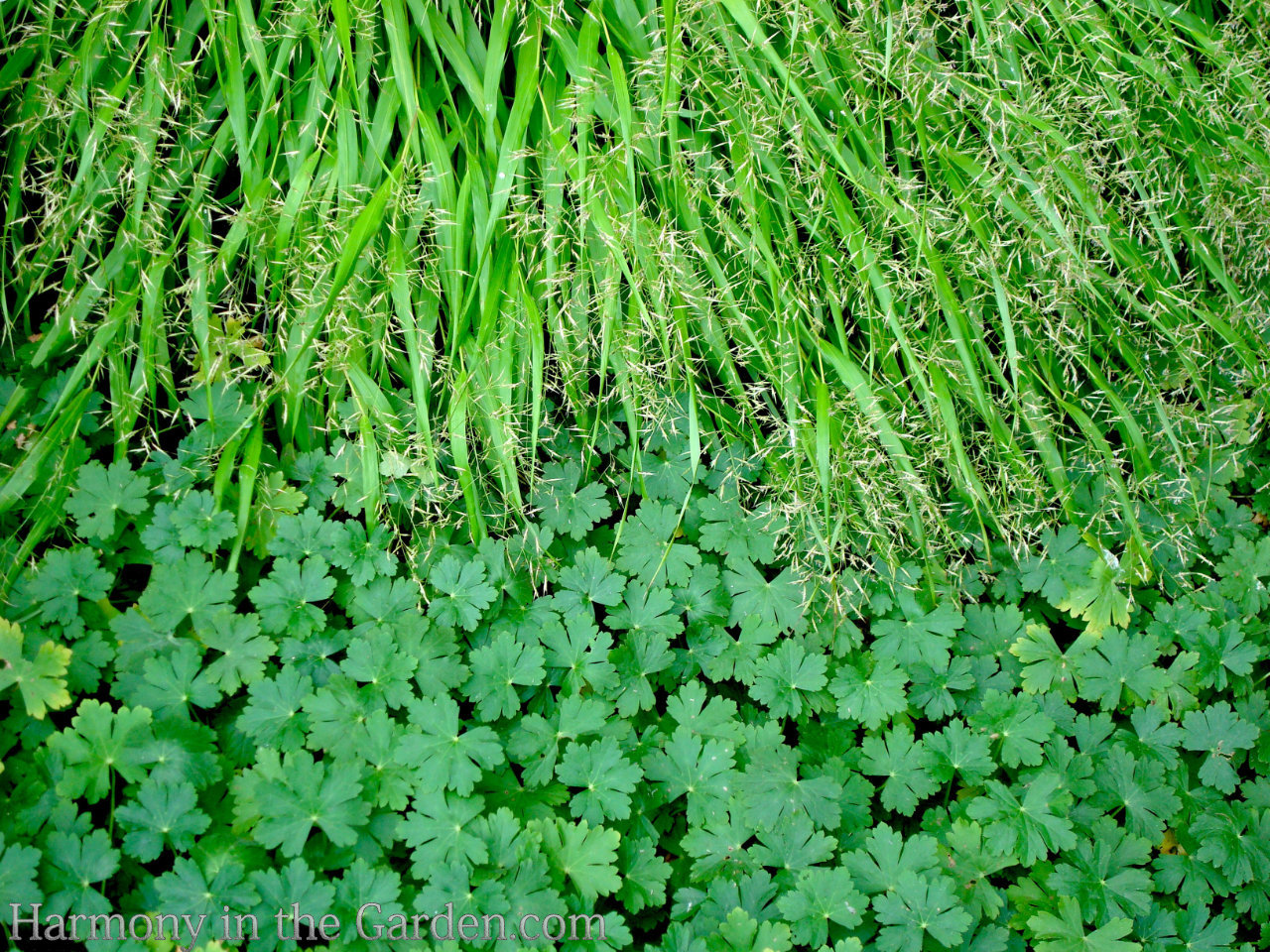
1. Create Contrast with Foliage
With many geranium and pelargonium varieties, foliage is the star of the show (versus the flowers, some of which can be a little nondescript.)
And, as we know, flowers are fleeting, but foliage sticks around for a loooong time, allowing for a wide range of design opportunities.
Depending on the shape and size of the leaf, I’ll often try and create exciting foliage combinations for maximum impact.
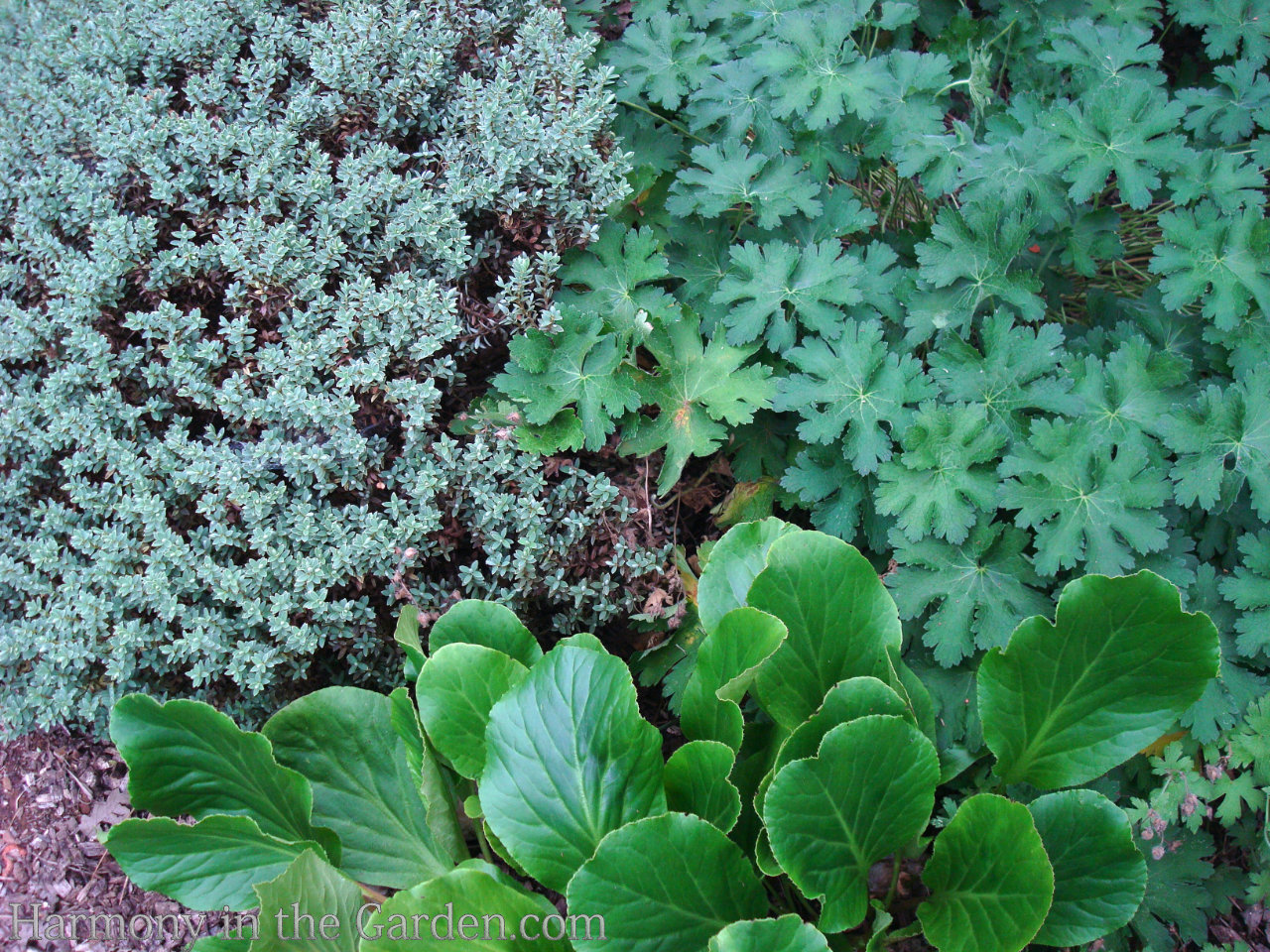
In this example, there’s loads of contrast thanks to the foliage of the oversized and glossy bergenia, the teeny-tiny gray hebe, and the deeply-lobed geranium.
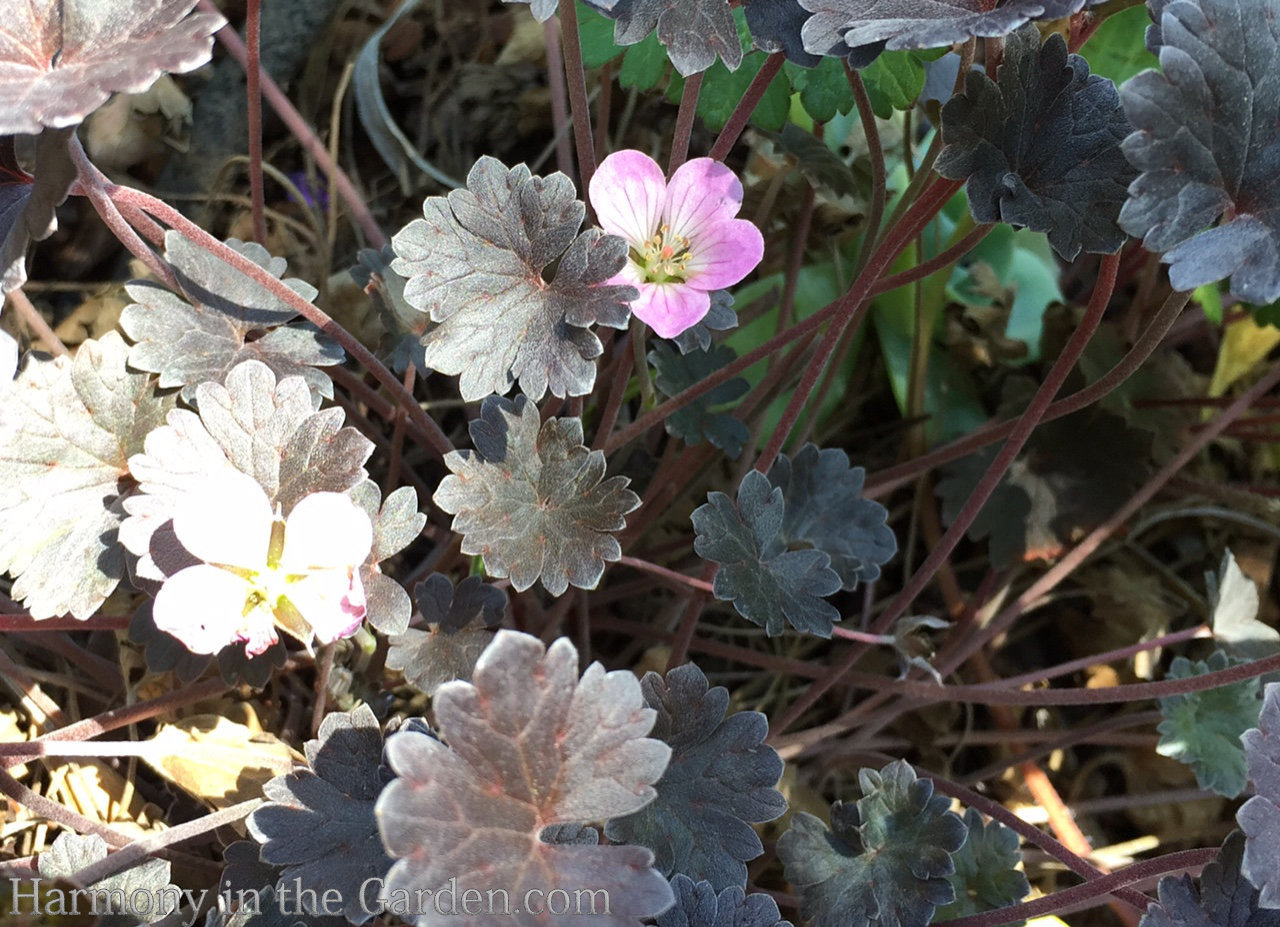
Maroon and burgundy foliage are some of my favorites to use in the garden, offering welcome contrast when placed near gray and green foliage.
Whenever I spot a dark-leaved geranium variety, I always snap them up.
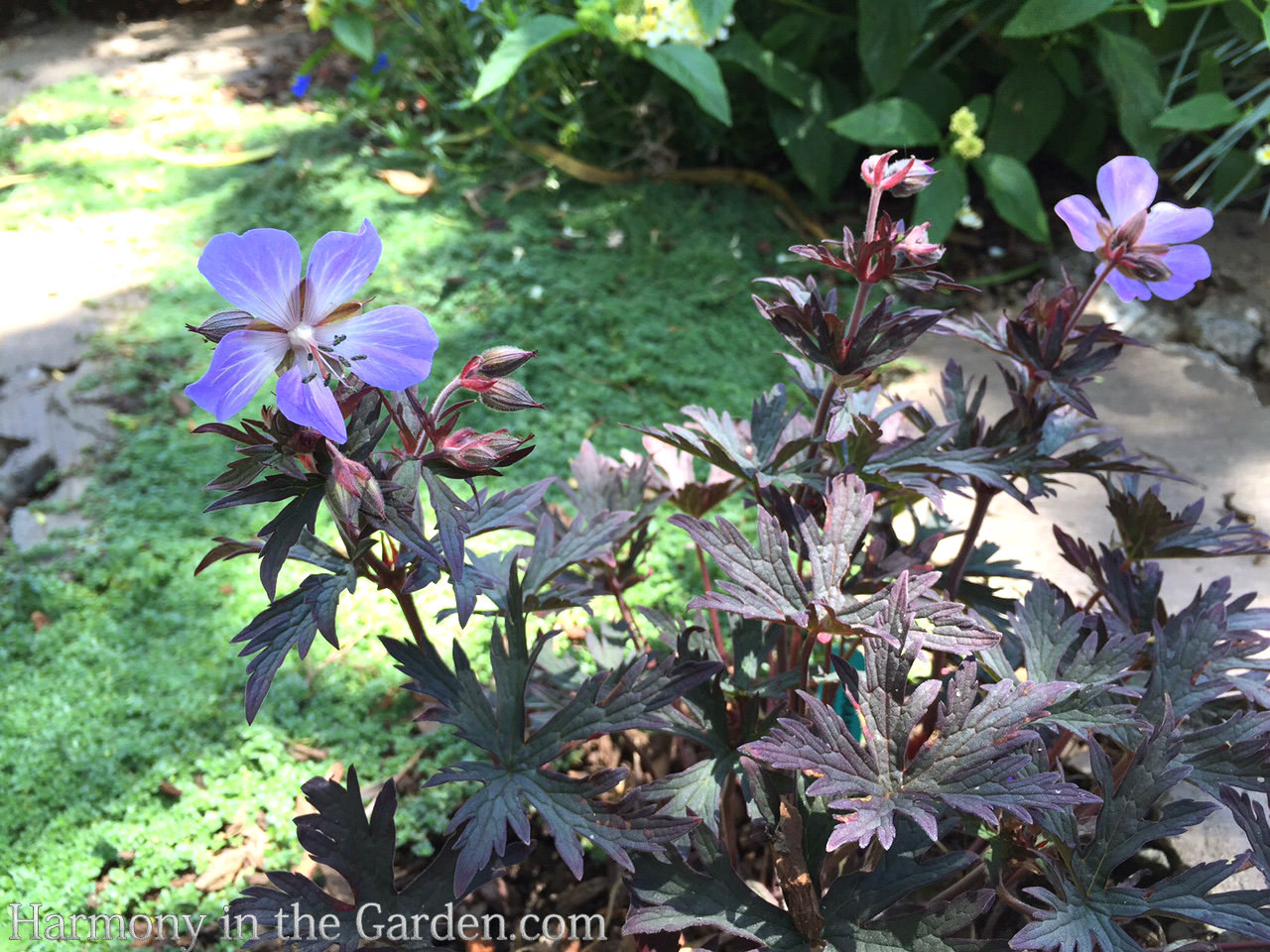
However, in my experience, the varieties with maroon foliage aren’t quite as hardy as those with green.
But that doesn’t stop me from buying them as they’re so darn pretty!
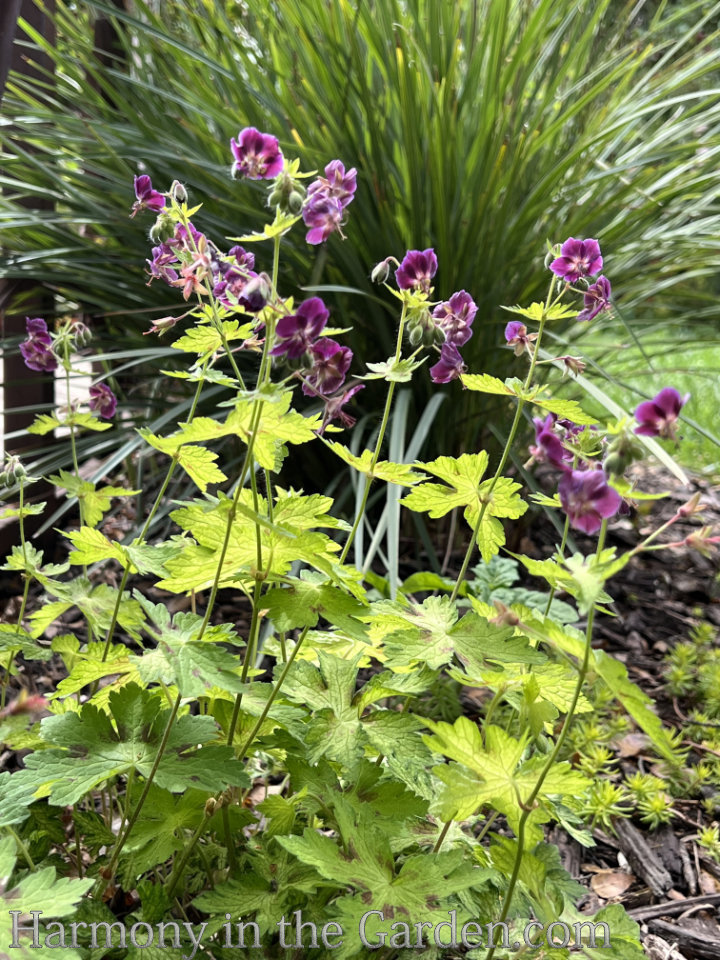
A few varieties have spotted foliage, like the Mourning Widow (left and below.)
And when in bloom, their rich, dark violet blooms offer a stunning repetition of the soft maroon spots on their leaves.
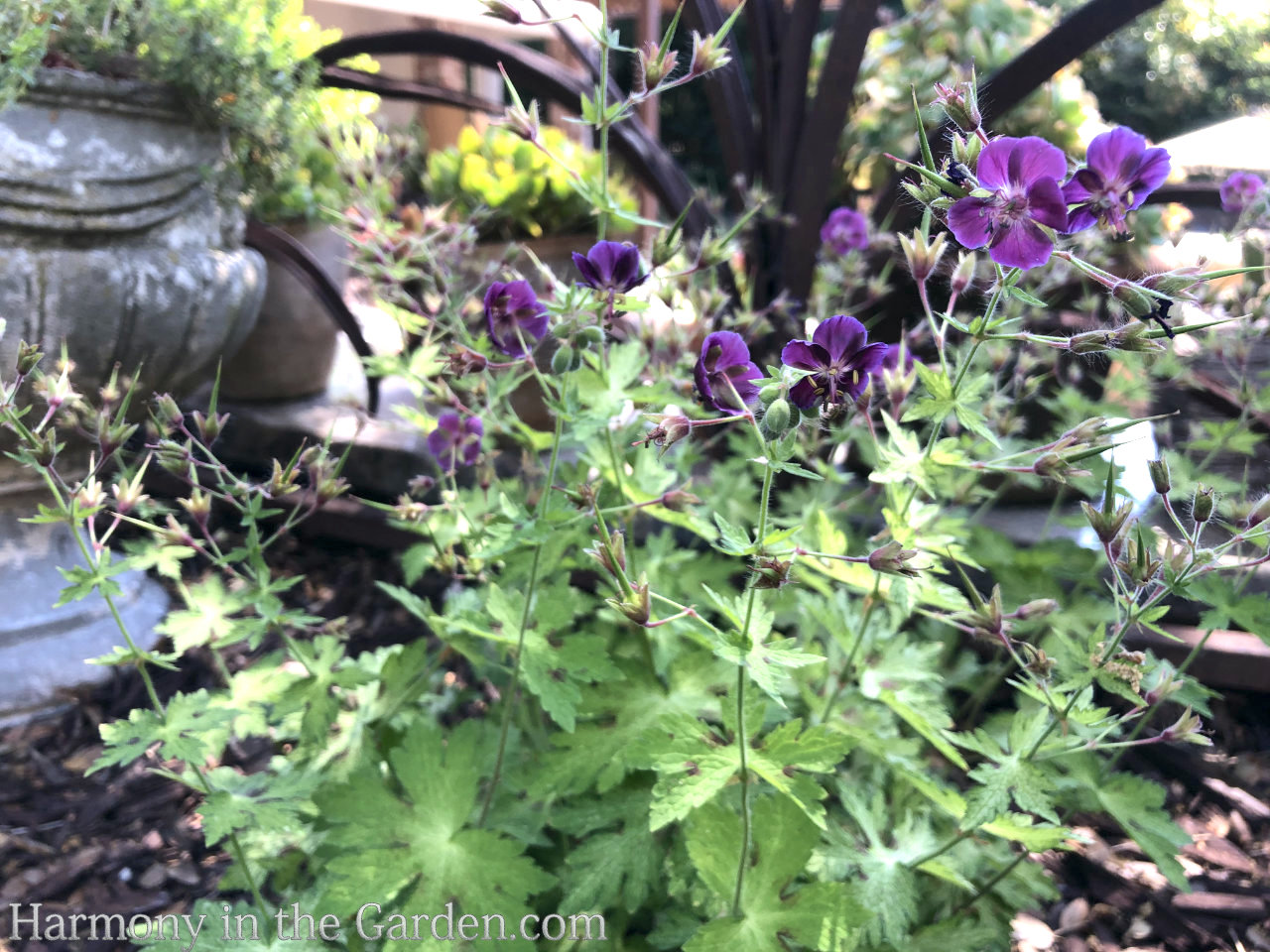
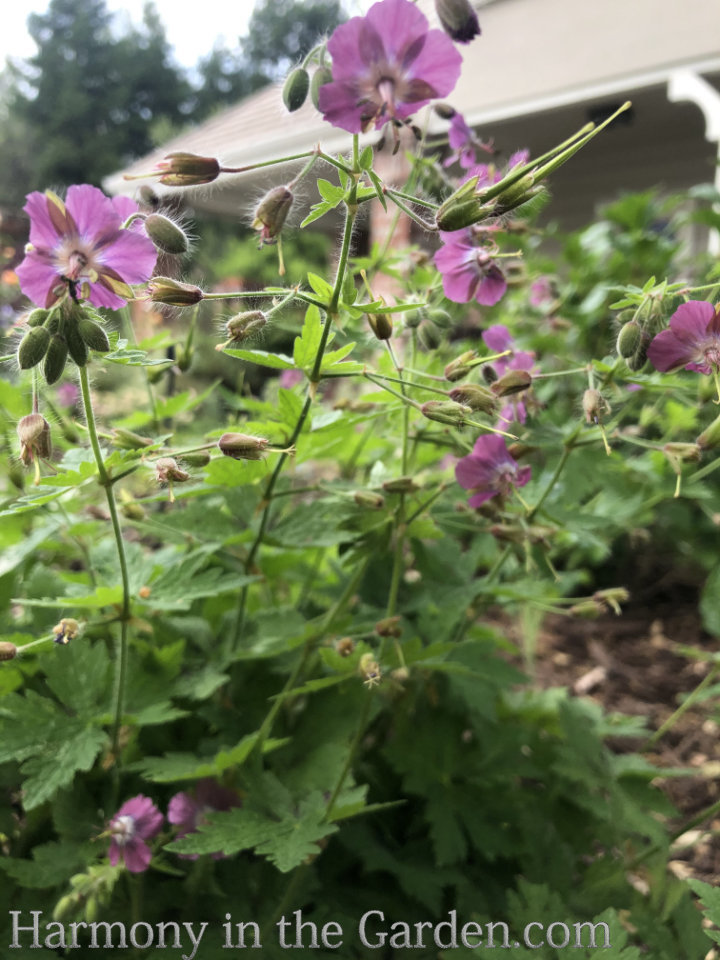
Another variety with spotted leaves is ‘Claudine Dupont.’
When planted next to the Mourning Widow (above) the soft mauve flowers make a lovely combination.
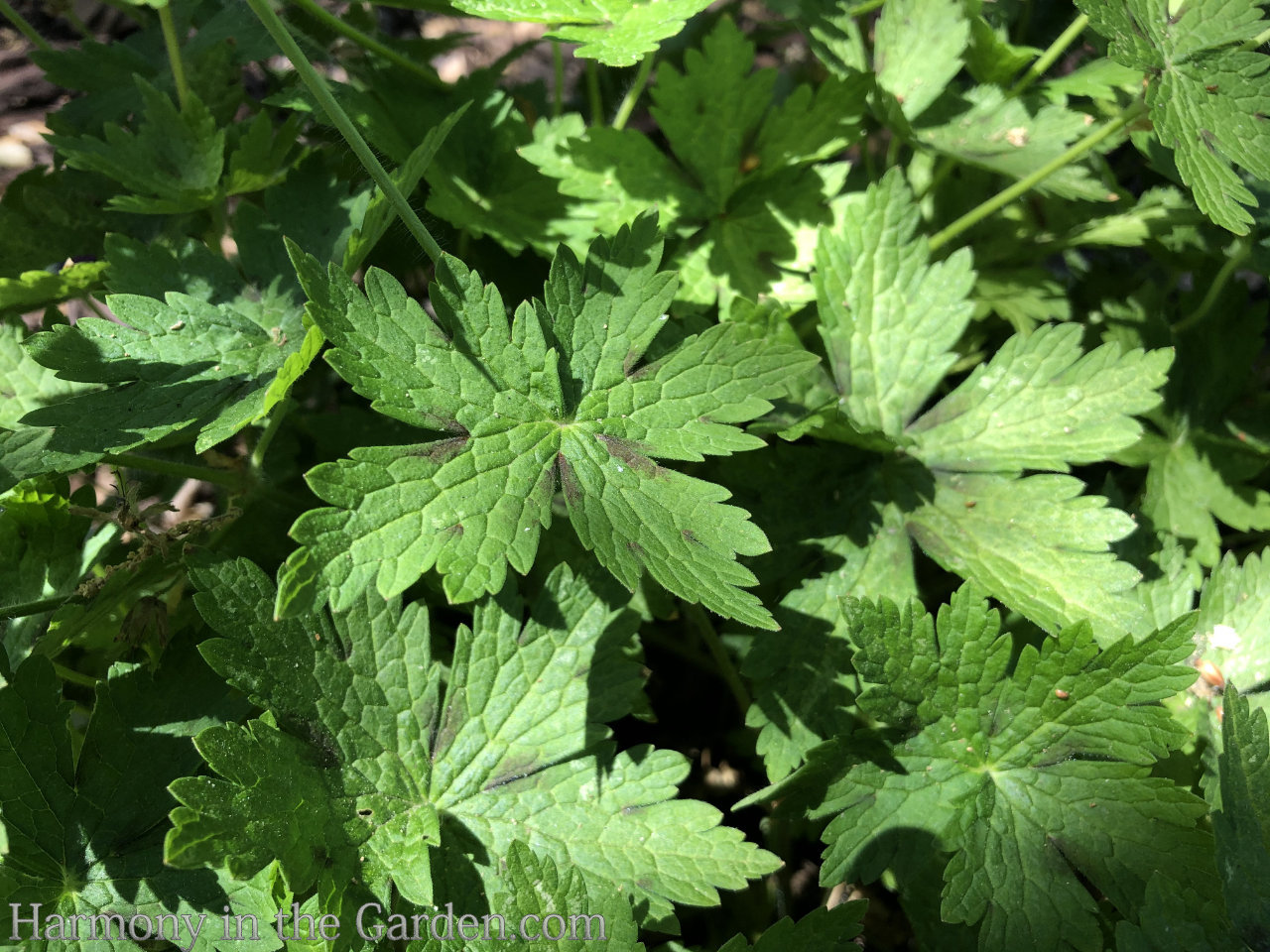
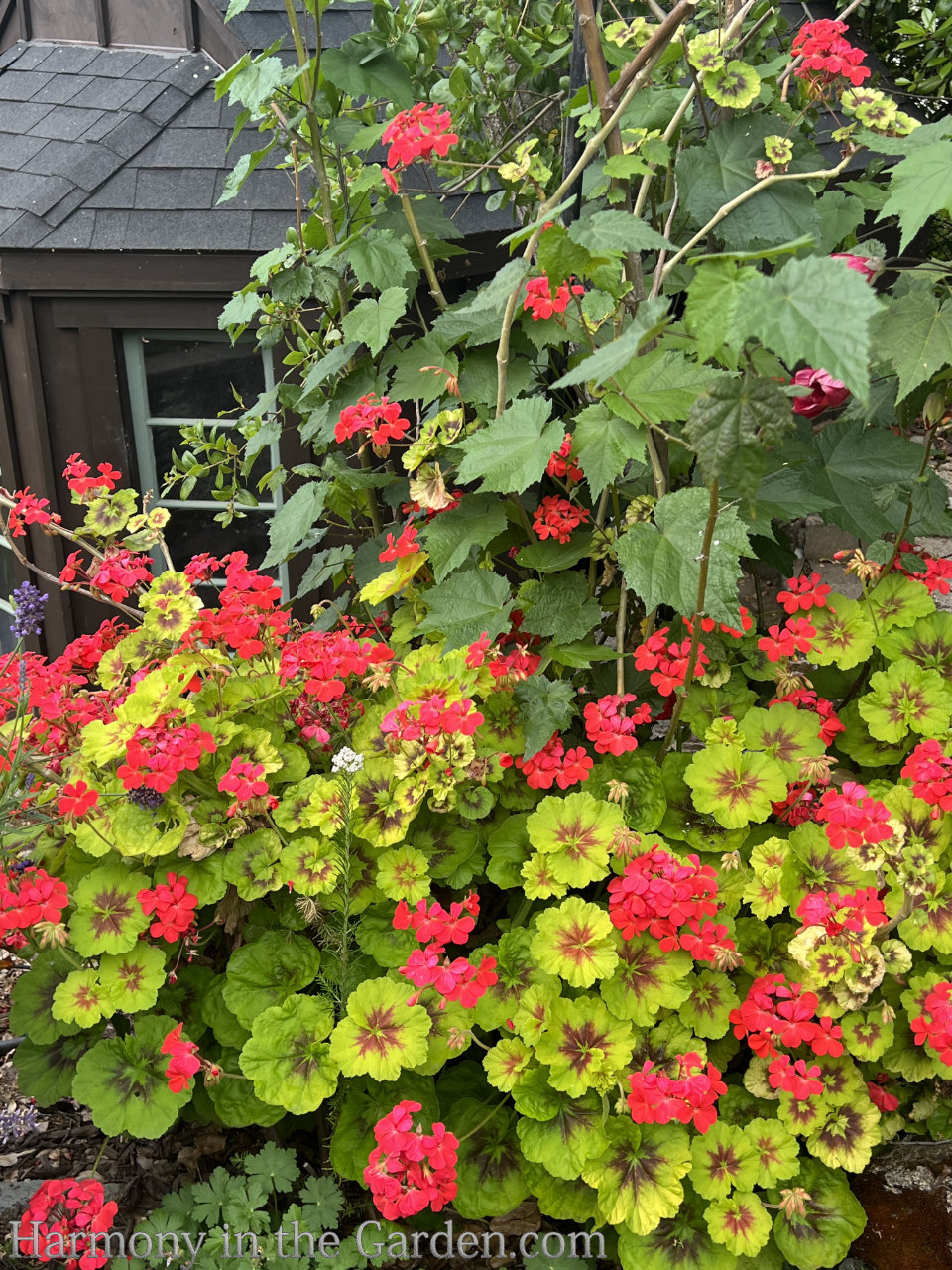
Believe it or not, I used to pick off the few coral-red flowers that would randomly pop up on this ‘Occold Shield’ pelargonium, as I felt it distracted from that fabulous foliage.
However, with all the rain we had this past winter, I couldn’t believe all the flowers, and how gorgeous they looked!
Never again will I prematurely remove the flowers!
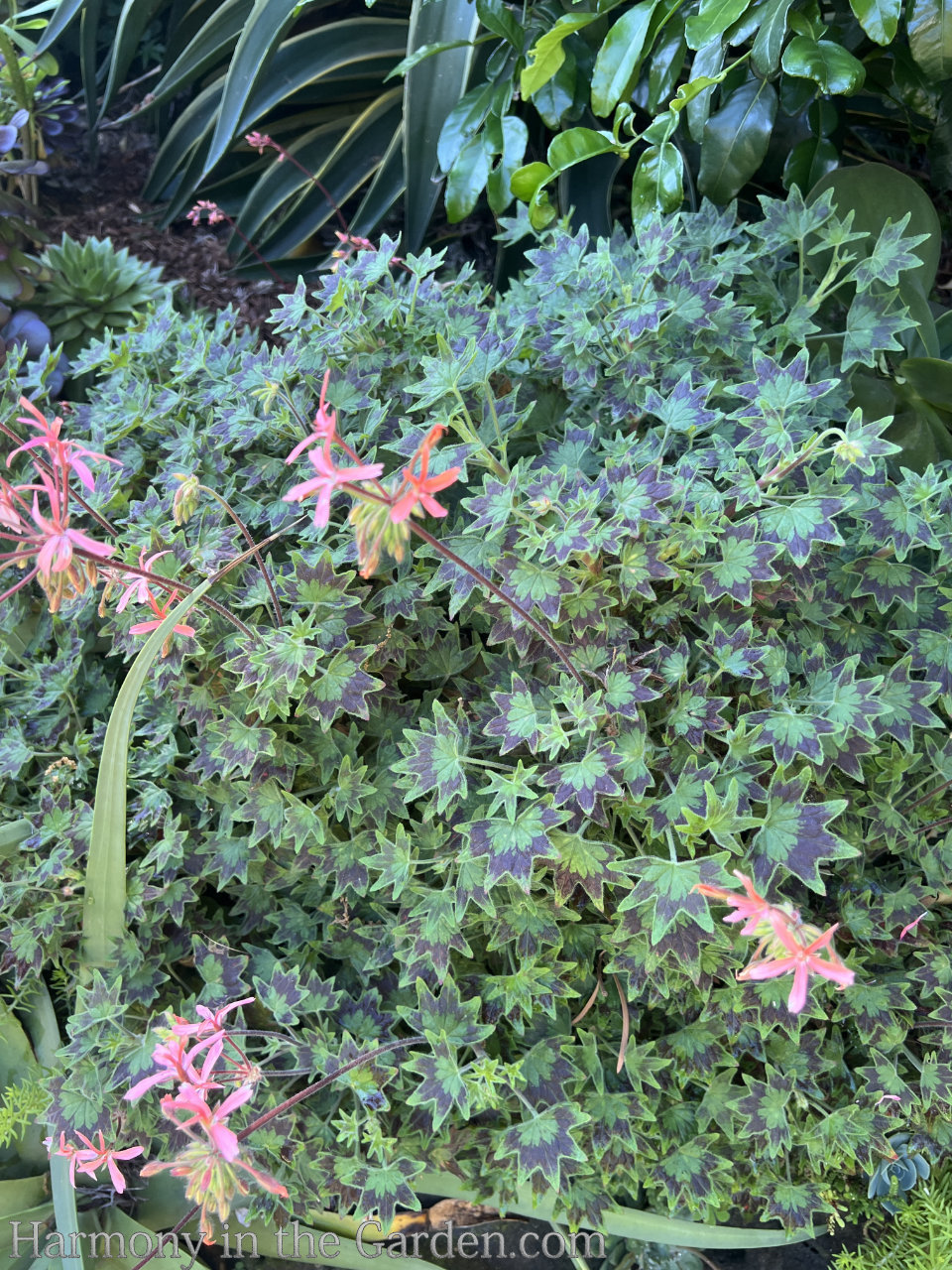
I recently spotted this ‘Bird Dancer’ while on a garden tour, and loved how it spilled out of the container to create a full and dense mound.
Similar to the ‘Occold Shield’ (above) each leaf has a dark maroon center, but instead of being rounded, the leaves are star-shaped.
I like how the starry shape of the pale salmon-colored flowers echo the star-shaped foliage, too.

When I first spotted the vibrant chartreuse leaves of the pelargonium cordifolium ‘Caroline’s Citrine,’ I was certain it would be too fragile to survive in my garden. But, always hopeful, I bought it anyway.
I’m delighted to say that it has survived four years now without ever showing ANY signs of distress!
It receives very little water in this part of my garden (competing with thirsty bay tree roots) and hasn’t wilted once in our recent frosty temps of 30-degrees.
I’m not a huge fan of the bright pink flowers, but luckily it doesn’t bloom that often. so I can appreciate that gorgeous foliage.
The leaves are huge too, growing up to 5-inches long.
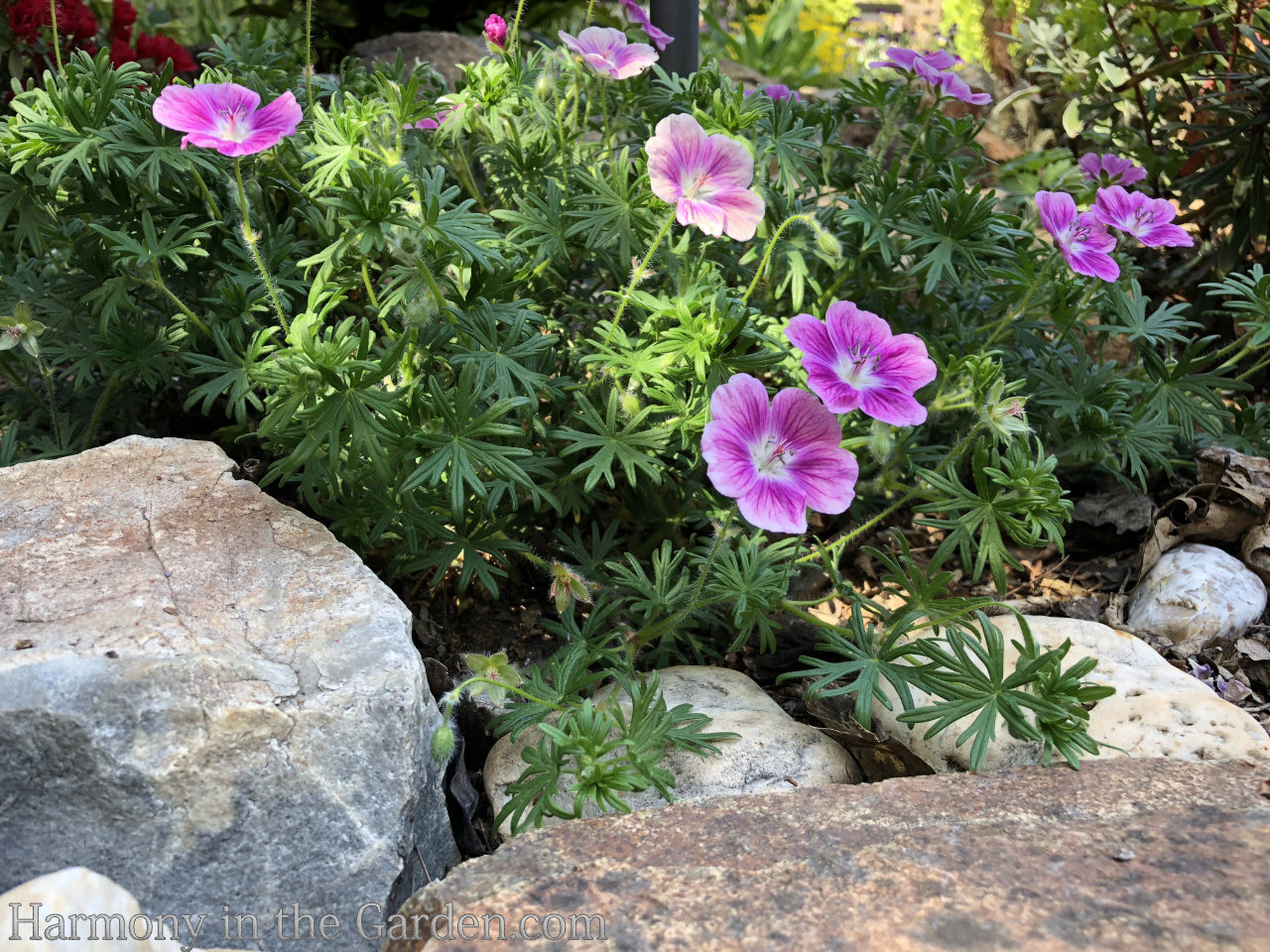
Unlike many other true geraniums, the foliage of ‘Elke’ is finely-dissected and fern-like, making it a welcome contrast in my garden.
While hot pink isn’t my favorite color in the garden, I make an exception for ‘Elke.’
The flowers, edged in soft pink, are quite refreshing when combined with the dark green foliage.
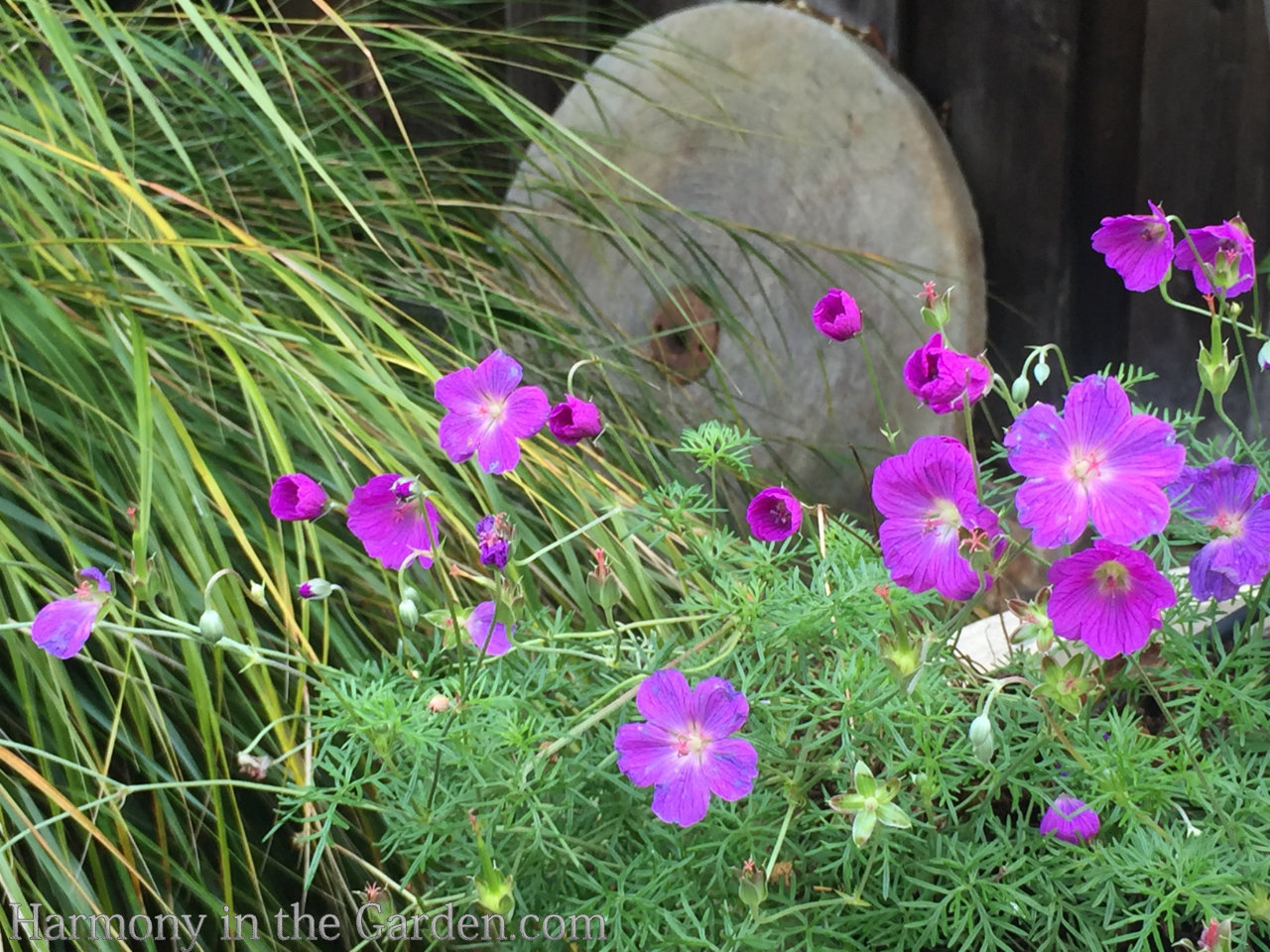
The Bloody Cranesbill (such an awful name, isn’t it?) is another variety with ferny foliage and vibrant magenta flowers.
Planted near the delicate blades of the hakone grass, the contrasting foliage makes a stunning combination (with or without the flowers.)
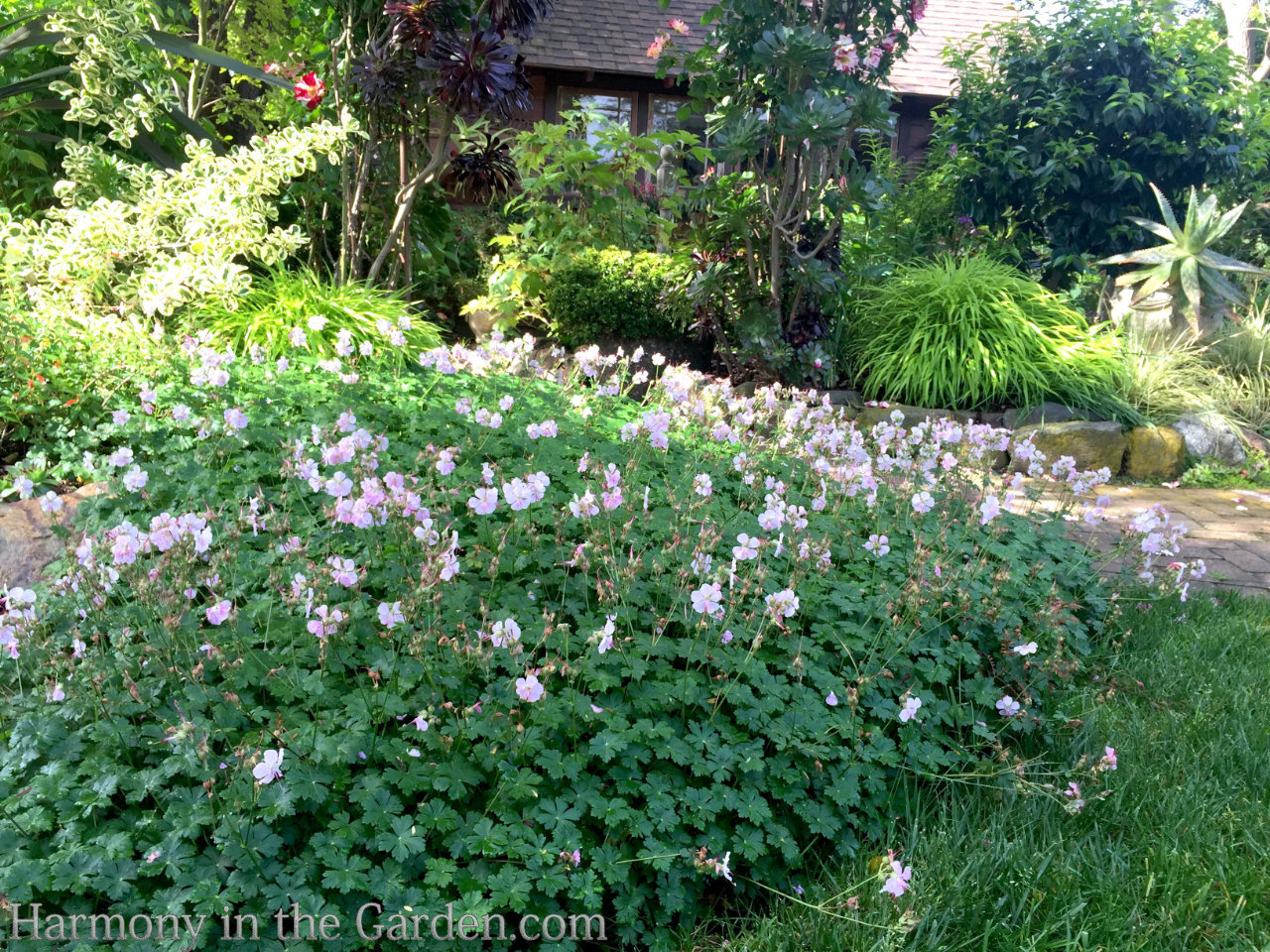
2. Create Drama with Drifts
Geranium ‘Biokovo’ is hands-down my favorite variety for creating a low-maintenance, evergreen drift in the garden.
Some varieties might have more colorful flowers than the pale-pink ‘Biokovo,’ but this variety has proven the most prolific and most reliable.
It’s quite dense and fast-growing, forming a low-growing, impressive drift that can be appreciated up close and from a distance.
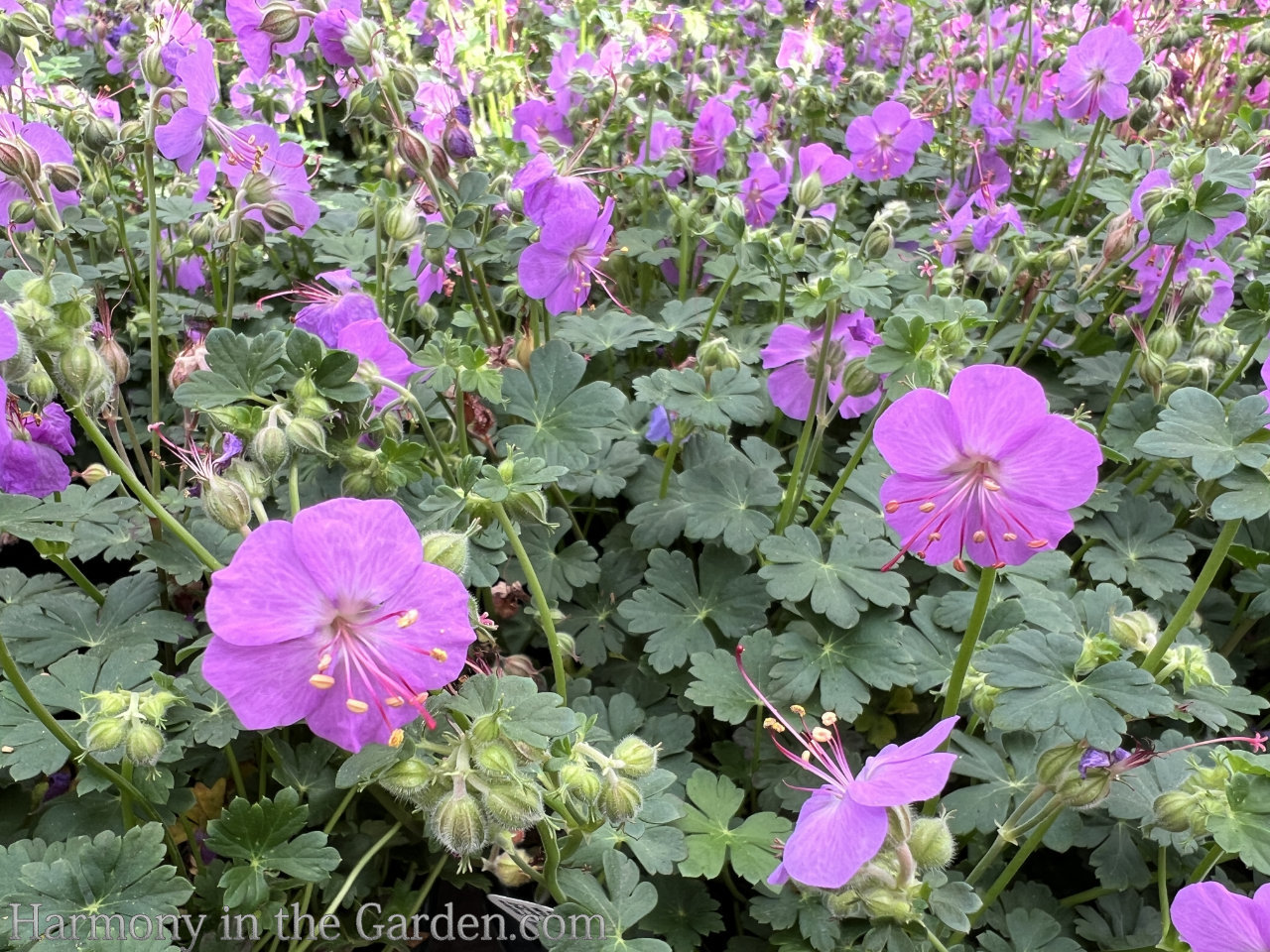
‘Cambridge’ is a newer variety to me, but even though I prefer ‘Biokovo’, I just had to try it!
The pink flowers have a touch of blue to them, which gives them a vibrant and almost iridescent color.
So far it seems to be just as vigorous and tough as the ‘Biokovo’, but it’ll take another full year of growth to know for sure.
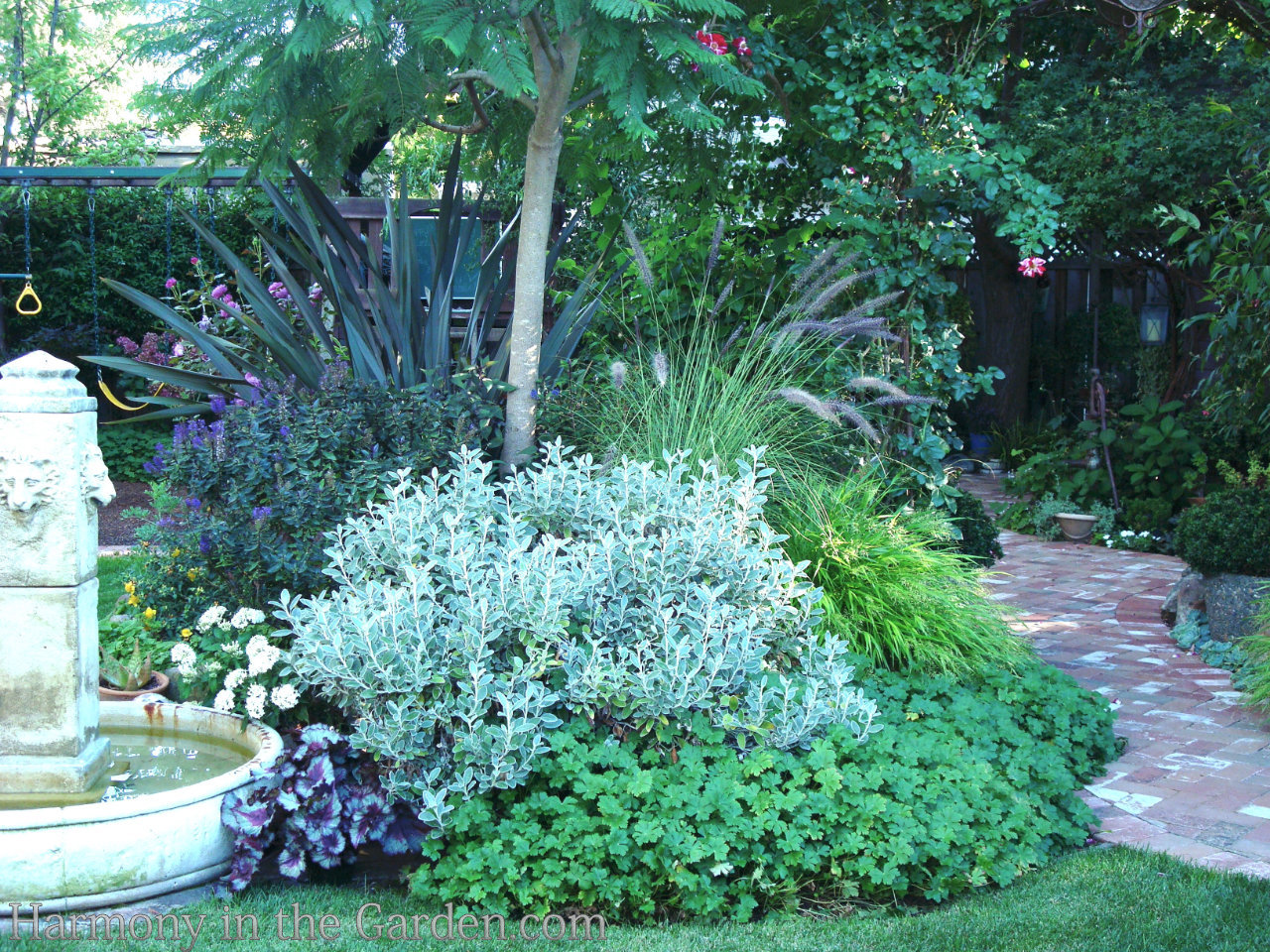
There are other varieties that quickly and easily spread to create weed-suppressing drifts.
A few of my favorites are g. macrorrhizum (aka: Bigroot Geranium) or the ubiquitous (but nevertheless stunning) ‘Rozanne,’ with larger blue flowers with a white center.
However, in the decades that I’ve been using ‘Biokovo,’ I feel it’s the most well-behaved and looks just as beautiful when not in bloom (left.)

3. Soften Edges
One of my favorite plants to softly drape over a stone wall, or raised terrace, is the geranium ‘Bill Wallis.’
It’s a delicate geranium, gently winding in and around other plants, popping up here and there with its tiny, vibrant flowers.
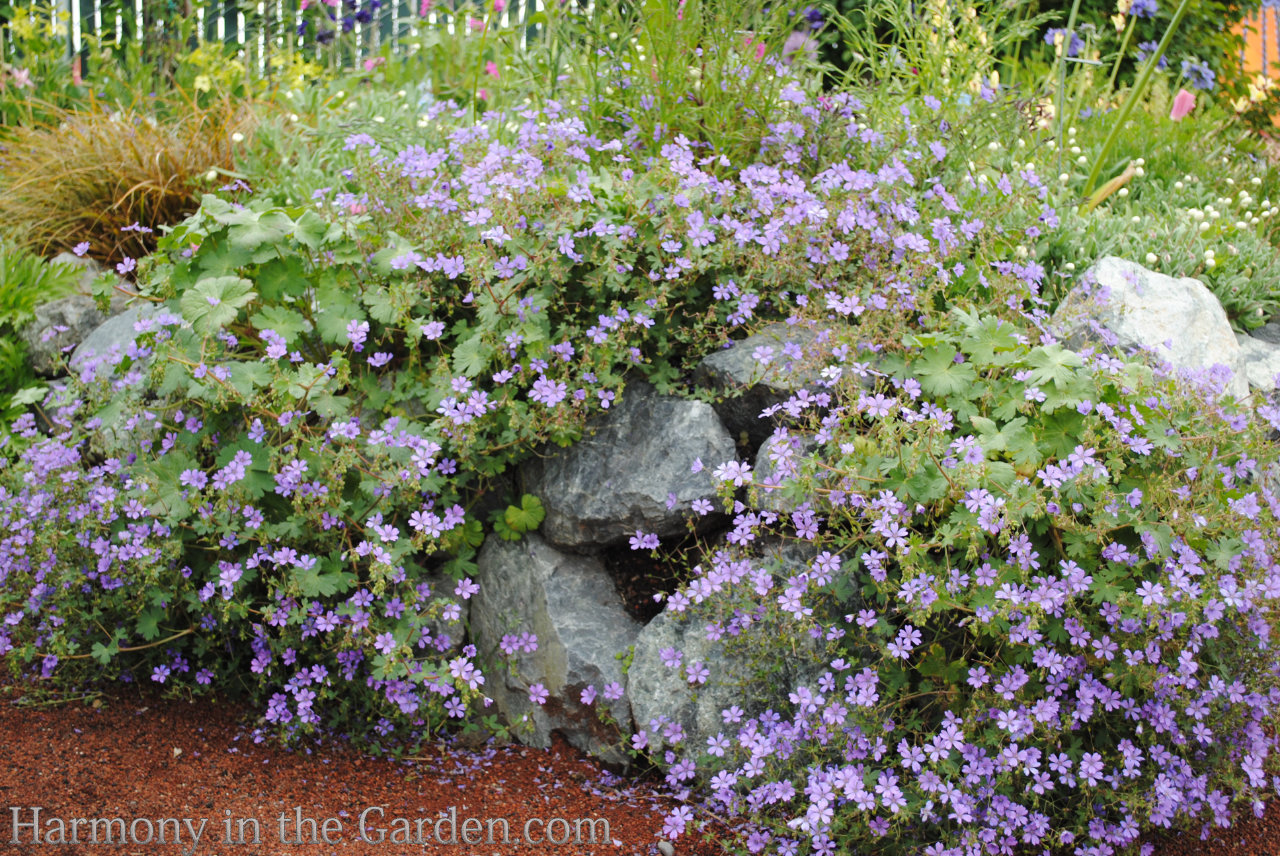
Like other true geraniums, its shallow roots make it a cinch to remove (or re-plant somewhere else in your garden) should it outgrow its space.
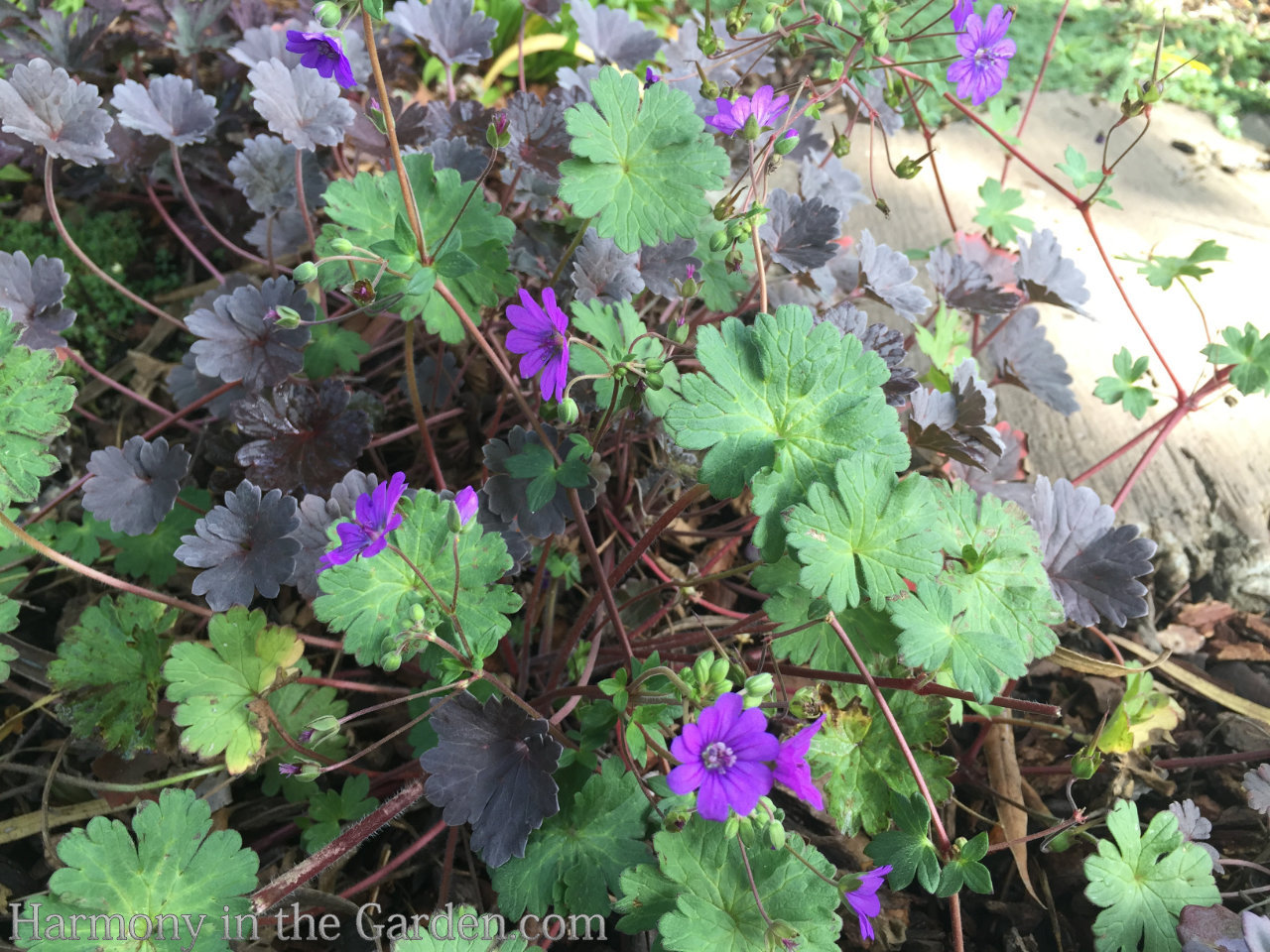
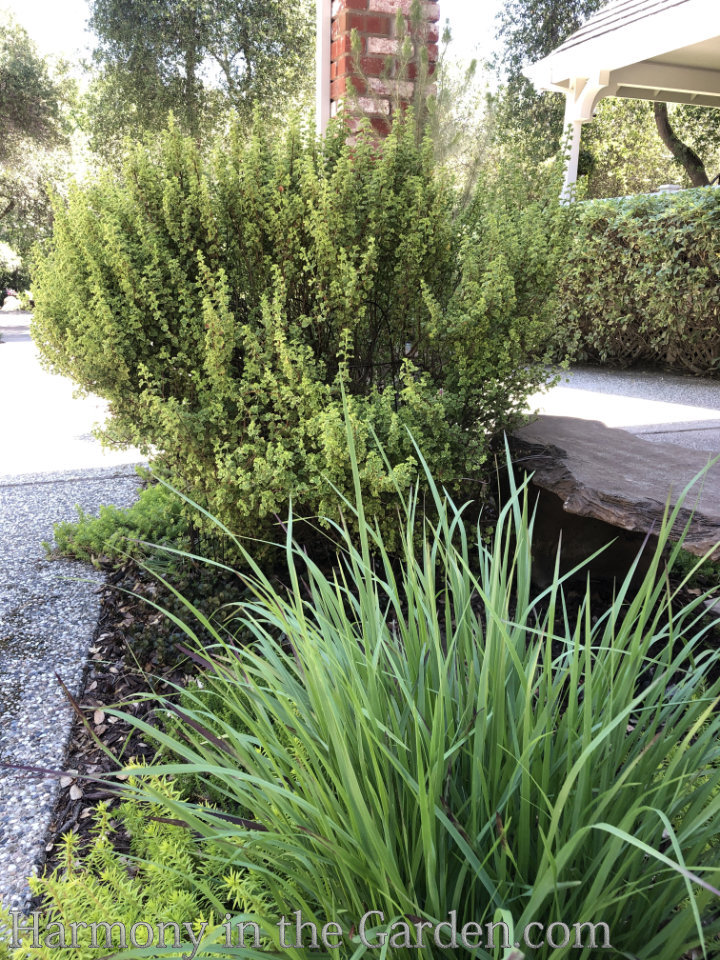
4. Scented Foliage
I’m in love with scented geraniums and have several planted throughout my garden.
Scented geraniums prefer lots of sun but I’ve found they survive better in partial shade when planted in super hot climates.
In my awkward driveway strip (left and below) my 4′ tall Lime-Scented geranium is the star, with succulents and grass planted in front of it.
In the below photo, I love how the lime color makes the purple of the tradescantia pallida ‘Purpurea’ even more vibrant. A fantastic color combo.
(click here for more about this awkward strip.)
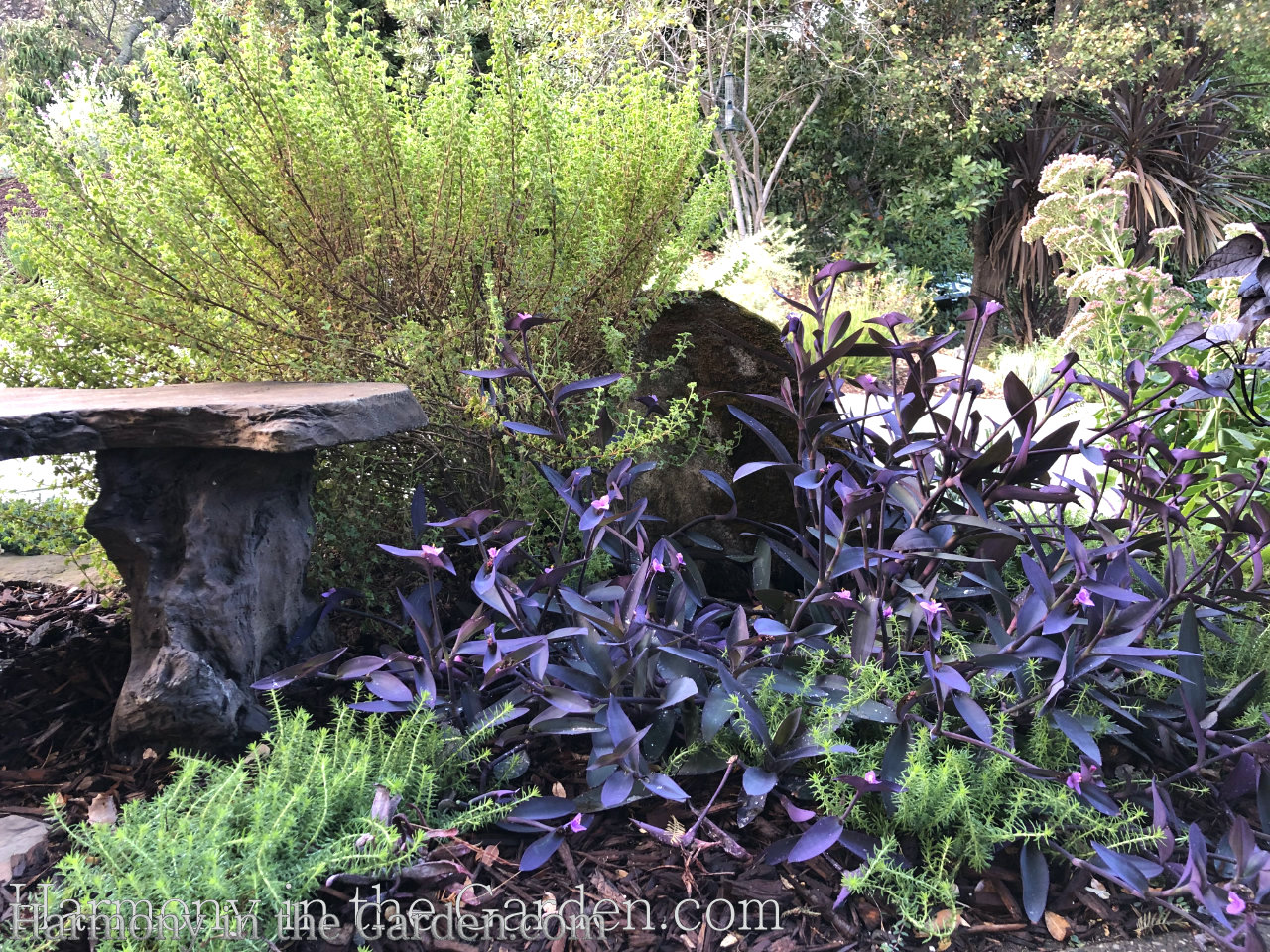
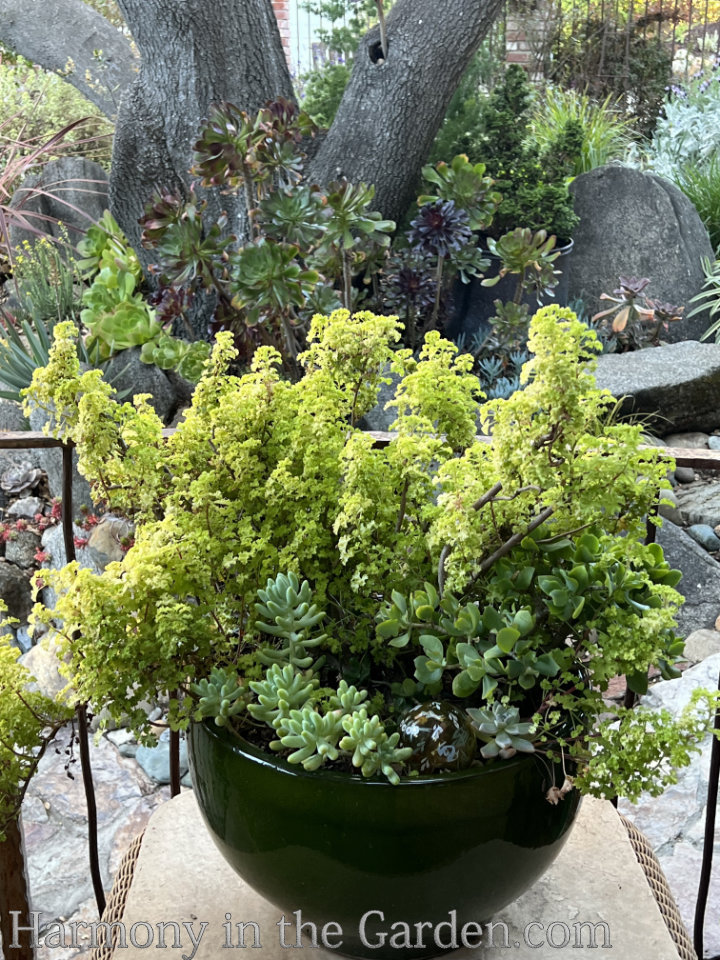
Pelargoniums really don’t like wet feet, so make sure their roots dry out between watering.
And speaking of water, mine are fairly drought tolerant with a bit of water twice a week in summer.
In my garden, they’re very low maintenance. In fact, the only time I prune them is if they outgrow their container or perhaps develop an errant branch.
Otherwise, they tend to take care of themselves year-round.
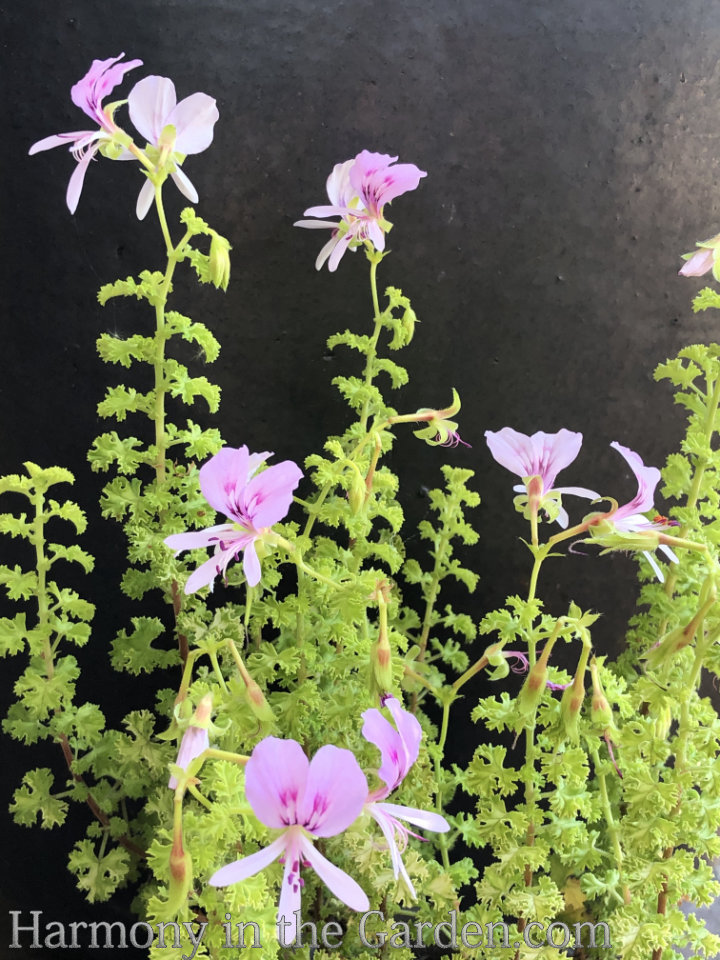
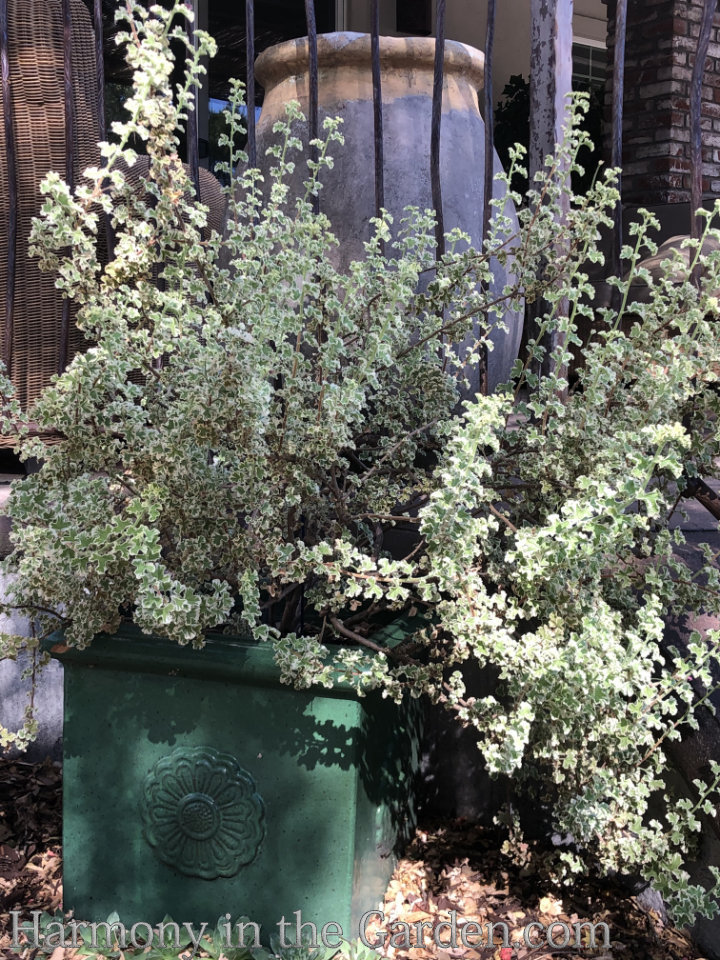
Scented pelargoniums are some of my favorites to include in year-round containers.
When placed on a patio (like the ‘Lime’ above, and ‘Prince Rupert’, left), it’s so much easier to appreciate their heavenly fragrance.
And since it can be difficult to maintain consistent moisture in containers, the forgiving scented pelargoniums are a perfect choice.
Scented pelargoniums are so much tougher than they look, and have lasted for years in my containers.

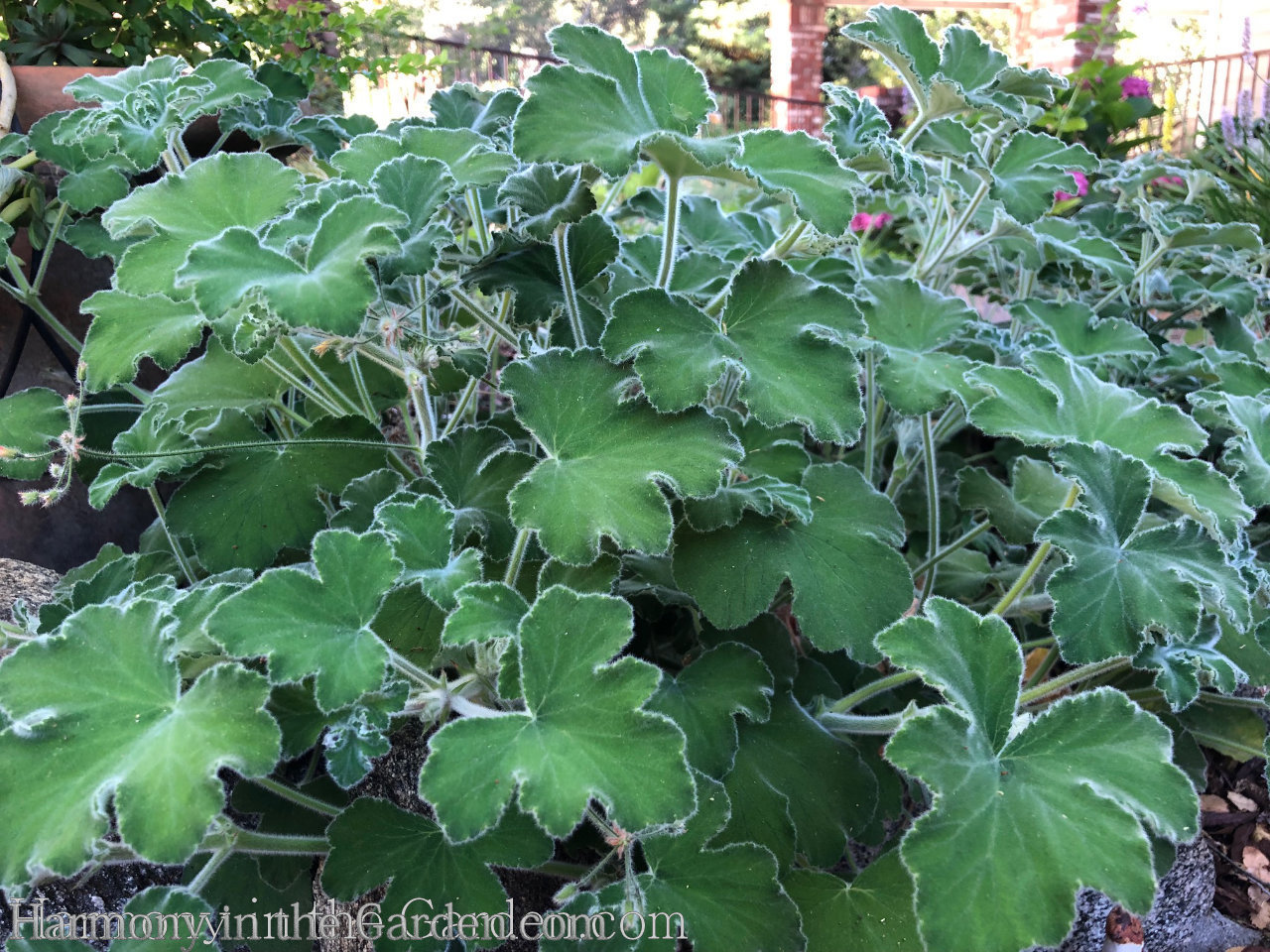
Softly brush a single oversized, 5-inch velvety leaf of this scented pelargonium, and you’ll be surrounded with a cloud of refreshing minty paradise.
In my opinion, it’s one of my favorite scents (not to mention textures) in the garden.
It’s more tender than the other pelargoniums in my garden, often freezing to the ground if temps dip into the low-30’s. Luckily, it always bounces right back.
It quickly grows to 2’high x 4’wide, making it a fantastic and fast-growing spiller or groundcover.
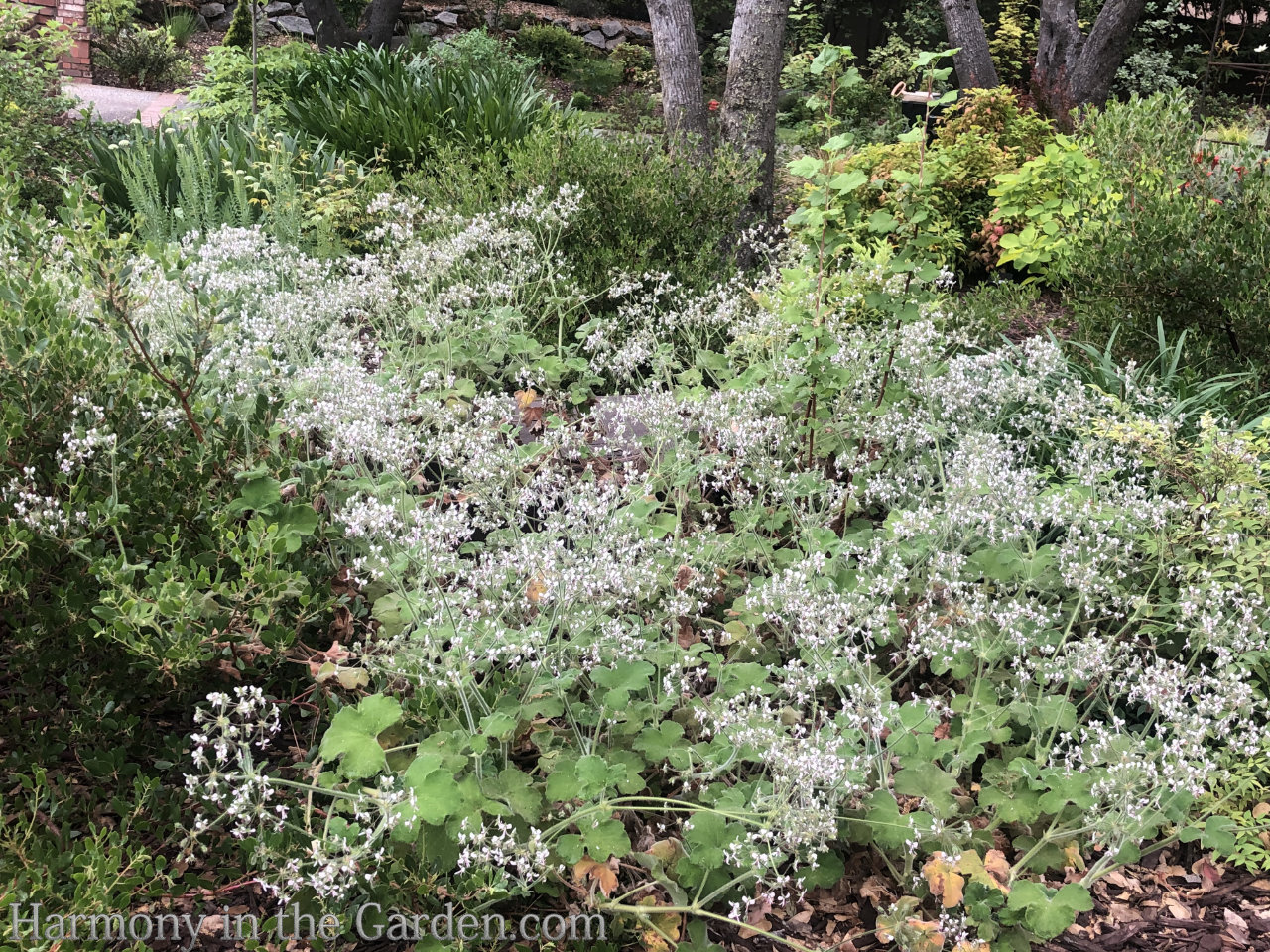
The foliage is unbelievably velvety, and I often carry around a single leaf in my hand while strolling the garden, lost in its delightful feel and fragrance.
In fact, click here to read why it’s an excellent choice in a therapy garden.
When in bloom, the entire plant is covered with hundreds of tiny white flowers, looking like a delicate white cloud landed in your garden.
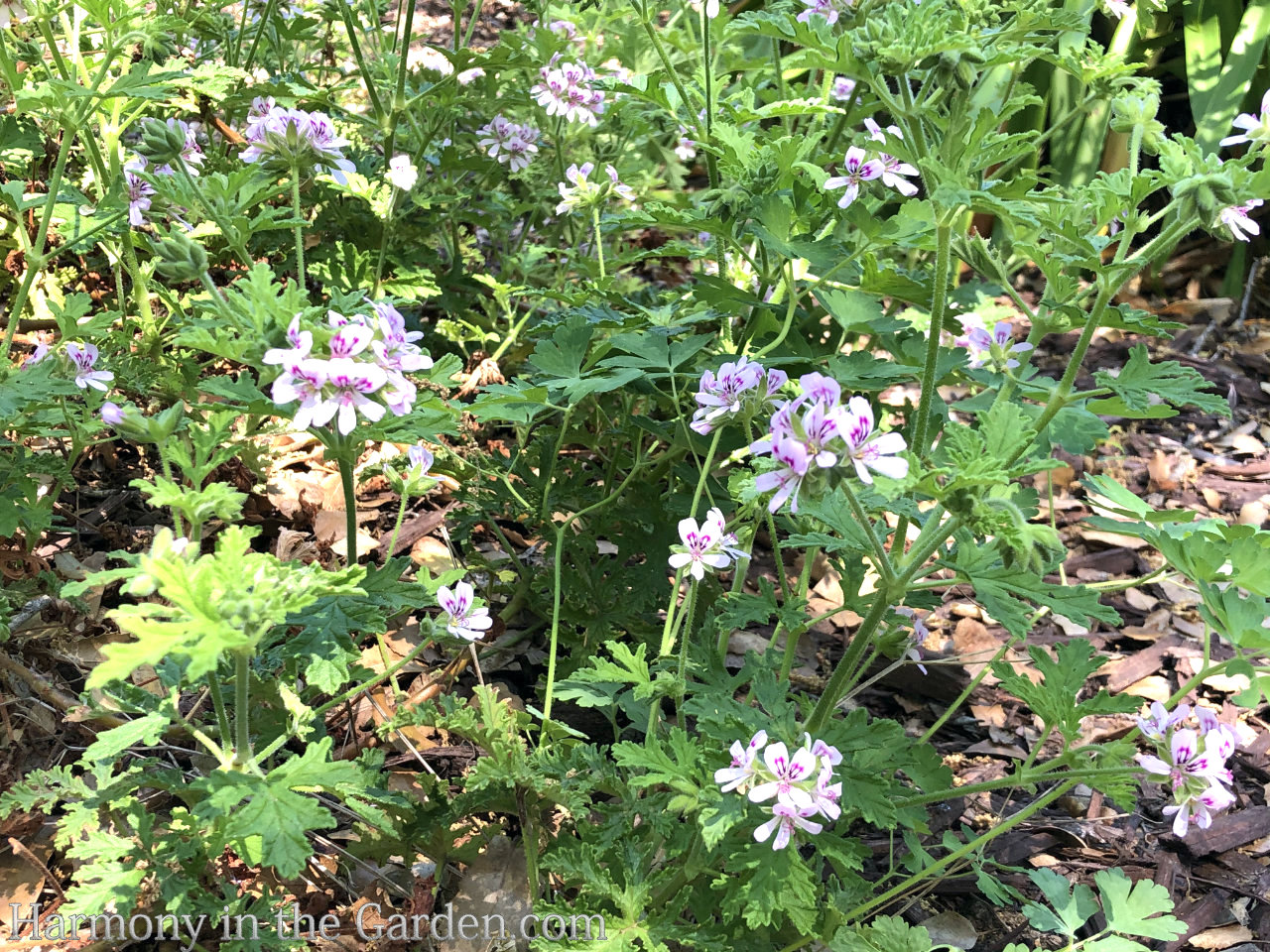
Also known as Attar of Rose, this trailing pelargonium’s rose-scented foliage is one of my favorites ever.
It can become a little rangy, loosely growing to 2’ x 4’, so I have it planted under my oak trees so it can sprawl to its heart’s content.
Deer have never bothered it, nor has drought, as it receives very little water.
And when I want a mental pick-me-up, I pick a small branch and bring it inside to perfume my home.
Click here for an interesting article regarding how it’s used in the perfume industry.
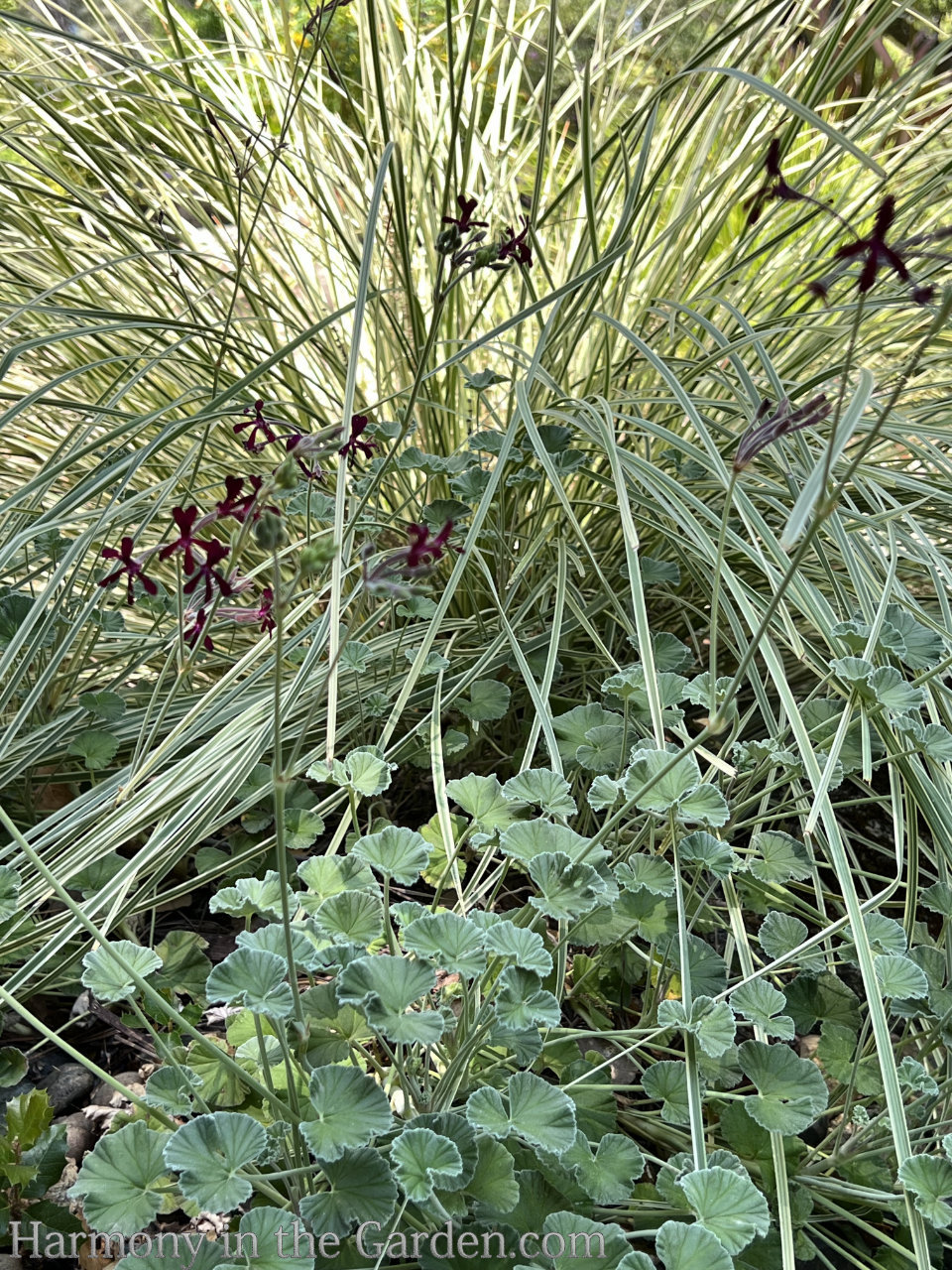
I’ve had this clove-scented pelargonium for years.
I just love the tiny, velvety leaves coupled with the dark maroon starry flowers that wave on tall, slender stems.
Here I have it nestled near a variegated lomandra ‘Platinum Beauty’ to highlight the contrasting foliage shapes.
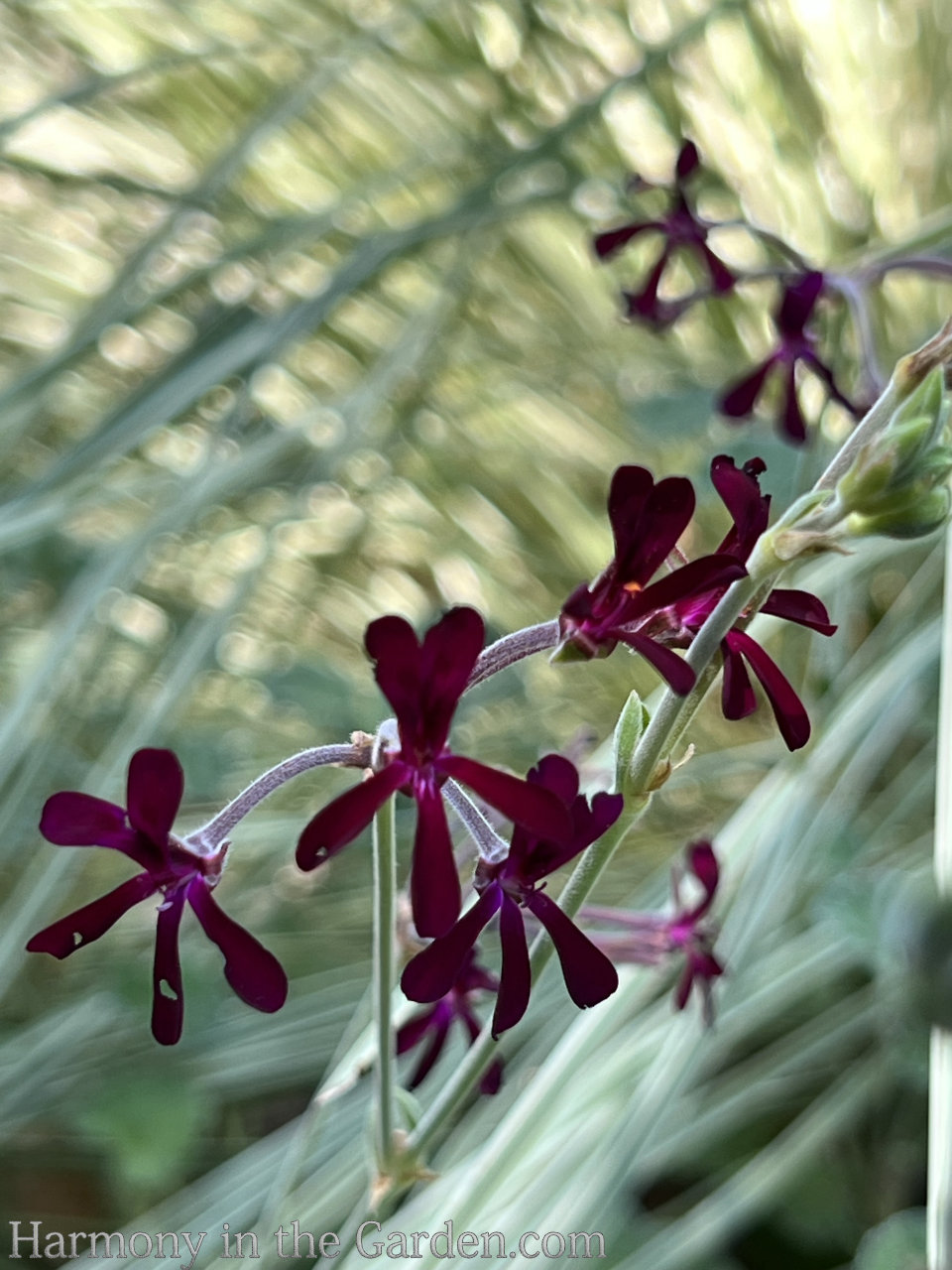
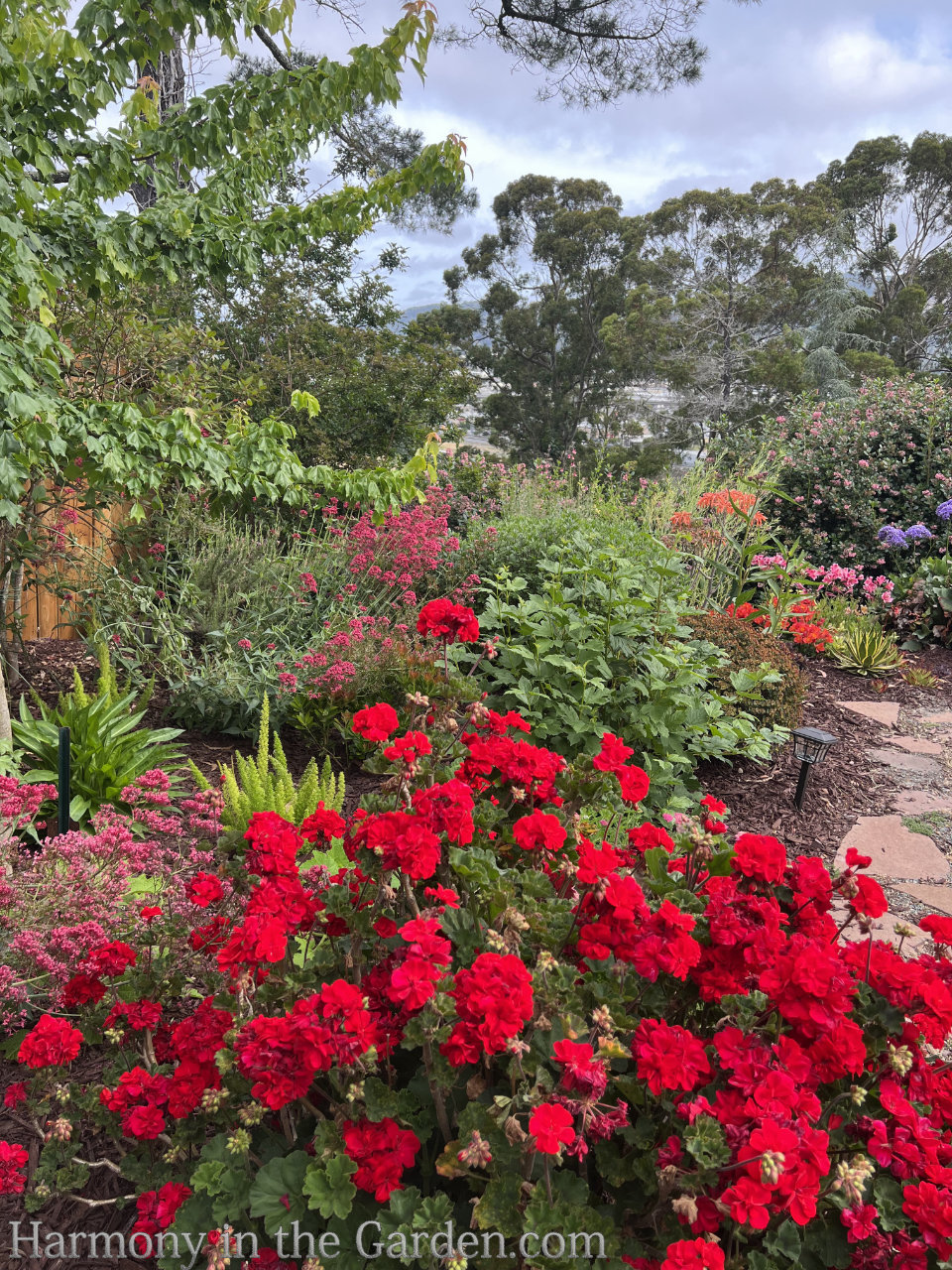
This post wouldn’t be complete without telling you a story about the common geranium (which we now know isn’t a geranium but actually a pelargonium!)
My grandmother had a huge deck around her home in Lake Tahoe, bordered with a twenty or so pots of geraniums in shades of pink, red, white, and everything in between.
When I was young and would visit her, she’d let me hand-water all of the pots (a chore I loved doing, feeling like I was such a big girl.)
Then (and here’s where it gets a little gross) she’d ask me to pick off and dispose of all of the cutworms that were eating her flowers (another chore I cherished.)
The worms were always crazy colors, either pale pink or yellowish or sometimes a dark plum color, dictated on whatever color flower they were devouring, I suppose.
It was sort of like an icky Easter egg hunt, and I loved it.
And what happened to all of her geraniums in the snowy winter?
She’d haul them all down into the basement, where she set up under grow lights on a long table. My poor grandfather would have to maneuver around this jumble of plants to get to his garage, but I think he secretly enjoyed it.
As children, my brother and I loved playing in this basement with all the humidity, greenery, and life surrounding us, while looking out the basement windows at the world covered in snow.
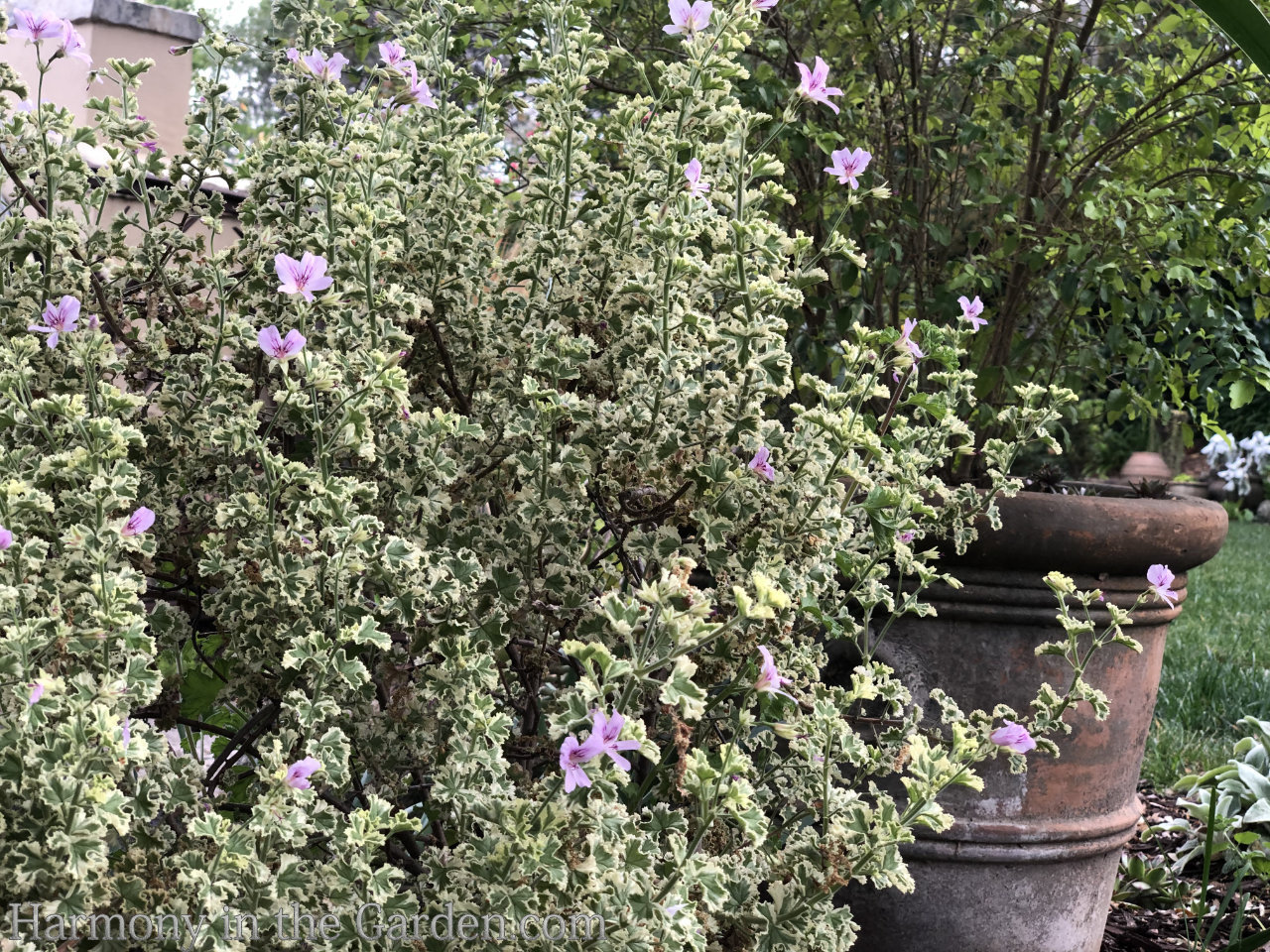
Oh, and for those of you who are looking for scented pelargoniums, two of my favorite sources for scented pelargoniums are Mountain Valley Growers and Geraniacea.
If you can’t find what you’re looking there at either of these nurseries, it may not exist – ha!
Both of these sites are filled with so much information and amusing stories, I think you’ll really enjoy them!
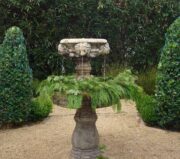


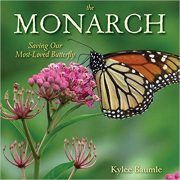
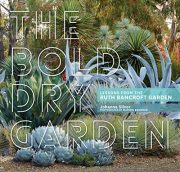

49 Comments
Loved this article. I will have to re-label most of my pelorgoniums.
Loved all the different types and since our house is on the Merced garden tour can’t wait to plant some!,
Chris Gilbrech
I love your newsletter every time and save it in my “Garden” folder for future referencing! I love geraniums and pelargoniums and agree they are most carefree. My favorite geraniums are Johnson’s Blue and Biokovo. Both are very satisfactory in my garden . I think I need to add a Dark Reiter for contrast. Also I have a scented pelargonium in a pot I bought at our garden club sale many years ago. It had no name and I see in your article it is probably Attar of rose. So thank you for that identification. And, thank you for the many wonderful photos you include in your newsletters. They really bring the newsletter to life!
Wonderful article! I grew several scented pelargoniums when I lived in San Jose CA. I have moved to So. Washington & am wondering if you have any scented pelargoniums that you can recommend for zone 8. I would love to be able to grow them in the ground here & not have to overwinter them in my greenhouse. Thank you!
Thanks for this great article and sharing all this information. Never knew there are so many varieties of Pelargoniums and Geraniums! It’s a chilly morning outside today but I’ve been enjoying your garden pictures and ideas as I’m drinking my tea and waiting for it to warm up outside. I want to try to find the minty-scented Pelargonium with the big fuzzy leaves-maybe the deer will leave that one alone. Thanks for the article!
I loved this article , as all of yours! I realize I have been calling all my pelargoniums geraniums….now I know! I will have to try some real geraniums in a new garden spot I am planning.
I love your blog and your books. Our mutual friend Susan Morrison lives in my area. I’ve grown geraniums for years.
Thanks,
I plant more of the real geraniums every year. Thanks for some fresh ideas. Hope you are well.
Currently I am in a group that is developing a small garden for an adult respite center. We’re about to choose the plants for it and I’m going to forward this blog to all of the volunteers because I think we’re going to want to include a number of geraniums or pelargoniums. They meet are requirements of hardy, scented, and gorgeous. Thank you!
Thank you for the informative article about geraniums and pelargoniums. I have never heard of pelargoniums but I am a beginning gardner and I live in a zone where they do not thrive outdoors. I have one geranium plant but now after reading this article, I am looking forward to trying some other varieties.
Oh, Rebecca, your articles are always so informative and inspiring! I like to keep pots with red pelargoniums on my deck because they are so cheery and make me smile. I also have some special hanging baskets with white, orchid, and maroon trailing pelargoniums that were started by my mother so many years ago. A little reminder of happy, bygone days! I haven’t had much luck with true geraniums such as ‘Bill Wallis’. I think it is just too darn hot in my South Bay garden.
I love my strongly scented pelargoniums. They are a very good weed suppresser under my drier South African shrubs.
It’s not summer without at least one pot of pelargoniums. I do have a hard time remembering to call them that.
Last summer I planted some Rosanne geraniums and I have a small patch of the Biokova I am trying to develop. I’d love to try some of the beautiful varieties you’ve shown.
Interesting article, I love my scented geraniums.
I have a mostly native garden but keep a pelargonium in a pot because it reminds my husband of his childhood. His mother grew it. This reminds me of the power of plants in preserving memories.
Pelargoniums were favorites of my grandmothers!! I need to diversify to more geraniums!
This might be the year to have Geraniums!
We love geraniums on our school campus because they are middle school student tolerant:-)
Geranium is way easier to say and remember:)
A lady gave a program at Merced garden club several years ago all about different geraniums. I always thought they were just ok, but with so many textures, colors, and scents I have grown to love geraniums more. I bought a white mesh geranium from the speaker, I love the pattern on the leaf. Gorgeous in a white pot. I probably should give it some fertilizer while I’m thinking about it.
That was Robin Parer. We should have her back. Her enthusiasm for geraniaceae is contagious!!!
Hope I win! Great prizes! I belong to both the Diablo Women’s Garden Club and the Danville Alamo Garden Club and you are my favorite speaker. Great info on Geraniums and Pelargoniums! I just bought 2 Pelargonium Charity from Robin in Richmond. Your info is a big help.
Thanks for explaining! Love the pictures. So many beautiful ones to choose from
Rebecca, Wow, was I lucky to check this out. I love the foliage of geraniums, and I loved the article. I will tune into the talks . I have always loved Johnsons blue cranesbill. Elke I must find withDark reiter and Springtime. I will mix them with my succulents. There is not a flower that I don’t like, so I am always in trouble in the nursery. Love and hugs J.
I had no idea there were so many varieties of geraniums. I have a few and I will get more. I’ve had fewer pelargoniums, but this year I have overwintered the one I had last summer. It has been flowering well.
Hello Bosom Buddy, I knew I had been intentionally channeling some of your garden wisdom for over 10 years and this article shows me that you seep into my subconscious too ! I have a specific “drift” of pelargoniums with a variegated leaves and two areas with contrast in folliage. These areas were unintentional in design. Yippee, I am “mainstream” without trying ! Thank you, Rebecca!
My love for geraniums and pelargoniums began when I was a little girl. I love the variety of scents and colors. The rose scent is so soft and lovely. I always have numerous pots blooming with A warm welcome to my garden guests.
Enjoyed this article – geraniums are some of my wife’s favorite plants and I look forward to planting more in upcoming months. I’ve had mixed luck in the past with certain geraniums not lasting (lack of water? Sunlight?). Feeling hopeful this time around.
I’m sitting here grinning. And I laughed out loud when I read your words about clearing up the confusion about the differences between geraniums and pelargoniums!
These dear plants have always held a place in my heart, probably for the same reasons you shared. Memories, memories entwined with their stalwart presence in my childhood and grown-up life. How can you fault a plant like an apple scented sweetie that asks nothing of you except an occasional sip of water and a nip back here and there.
Yes, I buy my scenteds from Mountain Valley and also from Robin at Geraniaceae Nursery in Marin.
Sending lots of love to you and Tom. Keep up the great, great work.
Geraniums are among my favorite plants. I also have several scented plants, but after reading your blog I clearly need more! Thanks for yet another wonderful, informative gardening article.
I have many hardy geraniums that I love and you’ve shown me there are more but I want to get… I’ve been having fun the last few years over wintering some pellagoniums that my friend had slated for the compost pile. They are in my unheated solarium and I enjoy seeing them all winter.
George G. March 11, 2022
In spring I often buy three different (flower color and leaves) pelargoniums that I plant in 6″ nursery pots and hang each one on a 4′ shepherd crook adjacent to driveway. Makes for an up close and personal display + easy care to maintain finished flowers, leaves and watering…
Thank you Rebecca for such a wonderful blog! Love scented geraniums and they are so easy to propagate.
Always enjoy your articles and beautiful views of your garden and landscapes.
I have some amazing geraniums, have a lot of the ones you have. Wish I could send you photos.
I am beginning to use more pots, as my palm trees have ruined my chances of ever having anything to grow. Also having a hard time watering them every day. Some of them have automatic watering systems, but not all.
Thank again for all your efforts in keeping us informed. ??????
Always looking for flowering plants that the deer don’t like…your article clears up my confusion over geraniums and pelargoniums…thank you. Excited to search out some of the varieties you spoke of.
Who knew! My grandmother always called them geraniums. I have a hard time switching to pelargoniums. My favorite with gorgeous neon orange bloom didn’t make it through our winter even with frost cloth cover.
last year I discovered the Roxanne cranesbill and have painted it in borders for that pop of color.
Thank you for this information. I’m sorry to say that I continue to call them all geraniums and truly love their beauty and scent. All of my cleaning products and hand soaps are geranium scent.
I love the scented geraniums and keep some in containers next to the house so that I can appreciate their scent better. I also have Johnson’s Blue and it’s a consistent performer. Thank you for all this wonderful information.
I brought cuttings of white pelargoniums home from Santa Barbara with me. Fortunately they are hardy plants and easy to root. I’ve stuck them in pots on my patio and am watching them slowly get established. Another one I have is scented and smells a little like citronella. Hopefully it will repel mosquitoes!
I love the perennial Geraniums. Looking forward to the Great Grow Along.
Thank you for this article. I can’t believe I have been calling pelargoniums geraniums! I love pelargoniums and have trained different varieties to climb a trellis on a fence outside our back patio.
Oh my gosh, I never knew there were so many varieties! I live in Reno NV and zone 7, did not know geraniums would grow here. Going to have to re-read all the varieties and see what to plant. As always your information is wonderful. Thank you
I so appreciate the pelargonium-geranium clarification. I have always had a display of pelargoniums by my front door and my granddaughters chose a couple for their raised bed. All are doing gloriously!
Some clients won’t have geraniums in their gardens because they think they’re “too common or old-fashioned” but often the old choices are still around because they are “tried and true”. Geraniums and Pelargoniums are reliable providers of color in the garden, and were drought-tolerant before the term came into everyday use in California. Thank you for your articles, Rebecca. I always enjoy them!
What fascinating information about geraniums and pelargoniums! Thank you! and Thank you for the opportunity to register for the Great Grow Along events and a contest. I look forward always to your blog postings.
Loved your article. My favorite geranium is Geranium cinereum’ Ballerina’.
Excited to visit those recommended nurseries.
I transplanted my geraniums to an area that does not receive water and they all died. How often do they need to be watered.
Thanks so much for providing a link to a virtual event!